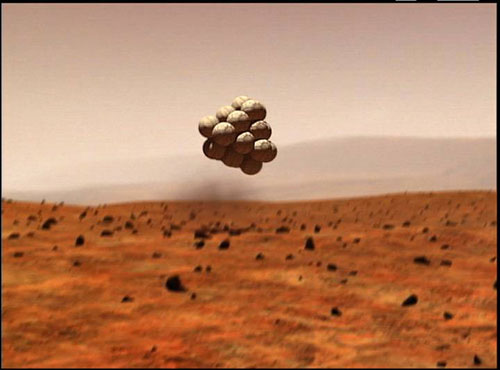- Introduction
- Mars Facts
- Mars Geography
- Mars Geology, Except for Water Geology
- The Martian Atmosphere
- Water on Mars
- Life on Mars
- Introduction
-
Mars
is the most fascinating---in general opinion---and sometimes the most ominous of the
unearthly planets.
- Mars in Myth and Early History:
Mars has been known since prehistory, of course---it's one of the historical planets (i.e., Mercury ☿, Venus ♀, Mars ♂, Jupiter ♃, Saturn ♄).
The ancient Babylonians associated Mars with their war and pestilence god Nergal. The ancient Greeks with their war god Ares---of whom few amusing stories are told.
Mars is, of course, also associated with the Roman war god Mars who was identified with Greek war god Ares.
-
To the naked eye,
Mars looks reddish.
This coloration may well have been the original reason associating Mars with war gods and pestilence gods.
Red like blood, inflammation, and a blood red eye---sort of like Sauron's---brooding over the Earth.
- Mars as Scientific Object: The Beginning:
As a scientific object, Mars came to the fore in the early 17th century when Johannes Kepler's (1571--1630) study of the orbit of Mars led him to discover that the planets had elliptical orbits. Note Martian orbit has a relatively high eccentricity of 0.0934 = 9.34 %, and so is a good case for the discovery of elliptical orbits. Among the historical planets (i.e., Mercury ☿, Venus ♀, Mars ♂, Jupiter ♃, Saturn ♄) only Mercury has a higher eccentricity (see file table_solar_system_planets.html), but Kepler may NOT have had such good data for it.
The nature of Mars itself began to be elucidated by the telescope. Using a telescope, Christian Huygens (1629--1695) identified the largest dark region on Mars, Syrtis Major.
In the 18th century, it was discovered that Mars has polar caps and sooner or later that they decrease in the summer hemisphere and increase in the winter hemisphere ???.
-
Mars has seasons
for the same reason that
Earth does. The
Martian axis is tilted from its orbital pole by 25.19°
which is close to the tilt of Earth's axis of 23.4°.
Mars's orbit is considerably more eccentric than Earth's (eccentricity 0.0934 compared to eccentricity 0.0167) and this must also affect the seasons more than Earth's eccentricity affects Earth's seasons.
Alas, this effect is really due to spring??? winds blowing lighter colored Martian dust off darker surfaces (HI-183).
Maps of Mars were produced in the 19th century, but really how good they were by modern standards, yours truly doesn't know---probably so-so for the largest features and rotten for anything smaller. See Giovanni Schiaparelli (1835--1910) map of Mars in the figure below.
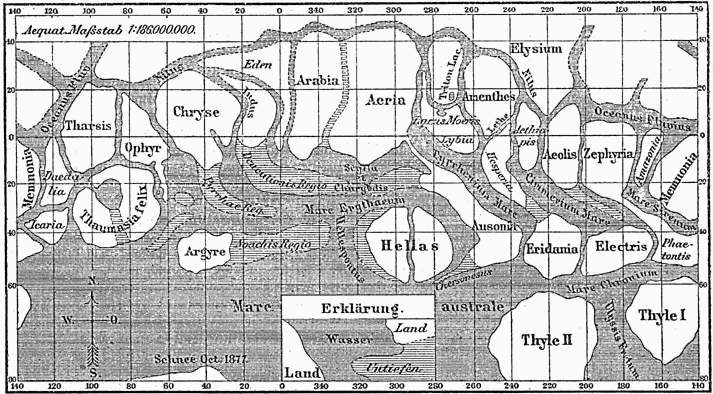
Caption: A German language "Historical map of planet Mars from Giovanni Schiaparelli (1835--1910)."
Some of Schiaparelli's names have stuck like Tharsis (see Wikipedia: Geography of Mars: Early nomenclature).
But yours truly doesn't know how well Schiaparelli's features actually correspond to the features we know today---was his Tharsis really what our Tharsis region is?---which, by the way, is a huge volcanic plateau.
It seems so, but nowadays we have much more precise locations and much better ideas of what the features are.
Note the surface feature classification box: it has a classification for "wasser" (German for water). Evidently, Schiaparelli did think there were extensive water bodies on Mars.
All a fig newton of his imagination.
Credit/Permission: Giovanni Schiaparelli (1835--1910) in Meyers Konversations-Lexikon (a German encyclopaedia), 1888 (uploaded to Wikipedia by User:Stefan Kuehn, 2005) / Public domain.
Image link: Wikipedia: File:Karte Mars Schiaparelli MKL1888.png.
- The Martian Canals:
In 1877 during a FAVORABLE opposition of Mars, Italian astronomer Giovanni Schiaparelli (1835--1910) concluded the Martian canals were a major feature (Ka-293). The canals were apparent linear markings on Mars.
-
A FAVORABLE opposition
is when Mars comes relatively
close to Earth.
- It is when the planet is closest to Sun and also on the Earth-Sun line, but on the far side of the Sun from the Earth.
- It is when the planet is farthest from Sun and also on the Earth-Sun line and between the Sun and Earth.
- It is when the planet is closest to Sun and also on the Earth-Sun line and opposite the Sun on the sky.
The most FAVORABLE opposition is probably a perihelion opposition.
Question: What is a perihelion opposition?
Answer 3 is right.Perihelion means closest approach to the Sun and opposition means opposite the Sun.
At perihelion opposition, Mars is about as close to the Earth as it ever gets.
Actually, because Earth's orbit is NOT quite circular (eccentricity 0.0167), the actual closest approach is NOT quite at the perihelion opposition of Mars (Wikipedia: Mars: Closest approaches).
See Mars in perihelion opposition in the diagram in the figure below.
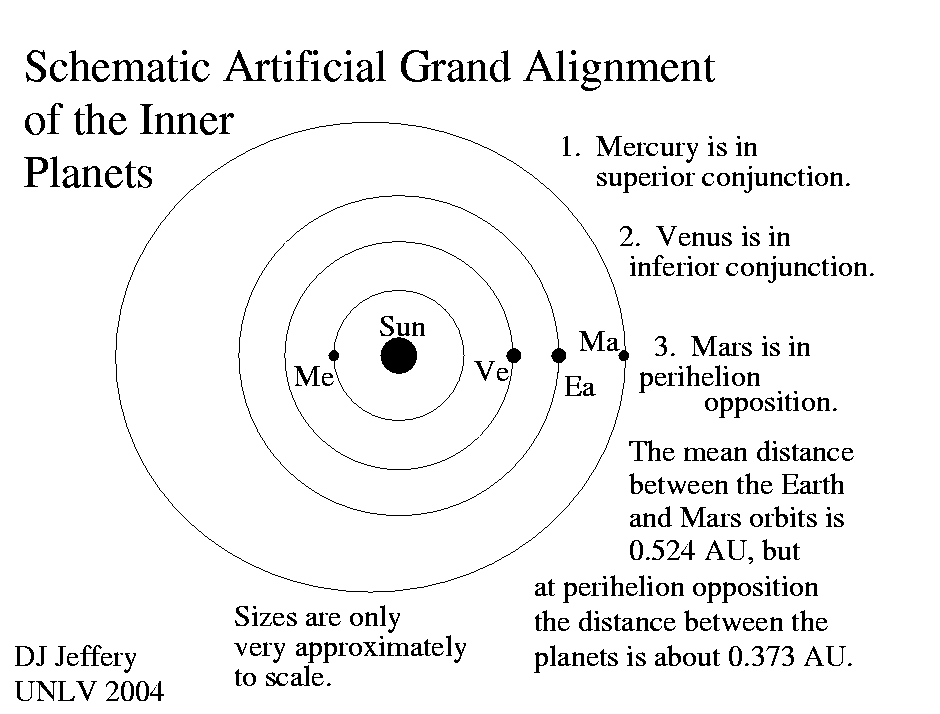
Caption: Mars in perihelion opposition.
Credit/Permission: © David Jeffery, 2004 / Own work.
Image link: Itself.
There was a very close perihelion opposition in 2003 Aug27 as you probably do NOT recall: the closest for ages (Wikipedia: Mars: Closest approaches).
Canale does have canal as its primary meaning in Italian.
-
The idea of
canals
was older than Schiaparelli. Linear features
had appeared on older attempts at mapping Mars and another
Italian astronomer Pietro Angelo Secchi (1818--1878) had first used the term
canali
in 1858
(Wikipedia: Martian canals: History of canals),
but Schiaparelli emphasized their reality and numerousness and
made them well known.
- The Martians:
The Martian canals they became in popular conception and some people became convinced they were constructions of intelligent beings: the Martians.
The most prominent of the believers in Martians was Percival Lowell (1855--1916)---who founded the Lowell Observatory in Flagstaff, Arizona. See Lowell in the figure below (local link / general link: percival_lowell.html).
- The Truth About Martians:
).Many/most astronomers NEVER believed in the Martian canals and always thought they were optical illusions---and all the talk about Martians was vastly premature.
-
In his day, Percival Lowell refuted
his critics who said his Martian canals were
just optical illusions, by saying that at
the Lowell Observatory in
Flagstaff, Arizona
he had the world's best observing site---for his day, you understand---and so could see what
others couldn't.
Lowell was right about having a good observing site, but he was still just seeing optical illusions.
The Mariner 4 images and other work showed Mars was a cratered world with a very low density atmosphere.
It was a quite disappointment to young scifi fans like me in the 1960s. No Martian canals, no Martians, no Thuvia, Maid of Mars. See the figure below (local link / general link: thuvia_maid_of_mars.html).
But mysteries remain:
- Mars has
water today in vapor and solid form and clearly it has had
liquid water in the past, but when and how much?
Is there sub-surface liquid water today?
- The Mars ocean hypothesis---did
Mars ever have an ocean?
The hypothesis is that a vast ocean covering about a third of Mars
existed in the northern hemisphere.
It's NOT established or dismissed.
- Was there ever life
on Mars in an earlier warmer, wetter time?
Is there life today below the surface in a deep biosphere: perhaps like the Earth's deep biosphere.
We've know since circa 1990 that there is a deep biosphere on Earth and microbial life can be found down to several kilometers in the crust (HI-196).
-
Question: In what temperature range can liquid water exist
when the atmosphere has Earth surface pressure?
- 273 K to 373 K.
- 0 C to 100 C.
Both answers are right.Just checking on who is awake.
To be more exact at standard 1 atmosphere pressure the freezing temperature is 0.00°C = 273.15 K. The boiling point is 99.975°C = 373.125 K (HRW-429)
Some microbial life can live at somewhat higher temperatures than 100 C when the water is kept liquid by high pressure (Wikipedia: Biosphere: Extent of Earth's biosphere
- Mars as Scientific Object: The Beginning:
See the image of full Mars in the figure adjacent/below (local link / general link: mars_full.html).
- Mars Facts
- A Mars Fact Table:
Below we give a table of some Mars facts.
________________________________________________________________________________________________ Table: Mars Facts ________________________________________________________________________________________________ Quantity Value ________________________________________________________________________________________________ Mean distance from the Sun 1.5237 astronomical units Eccentricity of orbit 0.0934 : which is the much larger than Earth's 0.0167 but much smaller than Mercury's 0.206. Mean inclination to Ecliptic 1.85061° Axis tilt to orbital pole 25.19° Orbital period 686.95 days = 1.88071105 years Rotational Period 1.02595675 days : This is the sidereal period Martian day 1.02749 days : just a bit longer than the rotational period for the same that Earth's day is longer than its rotational period. Equatorial radius 3,397 km = 0.53 R_Earth_equatorial Mass 6.424*10**23 kg = 0.1075 Earth masses Mean density 3.94 g/cm**3 : significantly less than mean Earth density Uncompressed mean density 3.3 g/cm**3 : significantly less than uncompressed mean Earth density and about same as the Moon's uncompressed and compressed mean density. Surface gravity 0.379 Earth gravities Surface temperature about -80 C (190 K) at night to -30 C (240 K) in the day on a summer day. This is surface air temperature. On a hot day in summer the ground temperature can rise above freezing (HI-187). Moons The Martian moons are Phobos with mean radius 11.1 km and Deimos with mean radius 6.2 km. They are both irregular in shape and may be captured asteroids, but there are rival theories. ________________________________________________________________________________________________
Sources: Cox-294,295; Se-418,479; HI-187.
________________________________________________________________________________________________
- The Martian Moons:
The Martian moons are two: Phobos (mean radius 11.2667 km) and Deimos (mean radius 6.2 ± 0.18 km).
They were discovered by Asaph Hall (1829--1907) in 1877 during a favorable Mars opposition---the same one that led old Giovanni Schiaparelli (1835--1910) to concluded that the Martian canals were a major feature of Mars.
The most common theory is that the Martian moons are captured asteroids, but rival theories exist (see Wikipedia: Moons of Mars: Origin).
Both Martian moons are tidally locked to Mars, and so turn the same face to Mars all the time (see Wikipedia: Moons of Mars: Characteristics).
The tidal force on Phobos is causing it to inspiral and it will break up and impact in fragments on Mars probably in 30--50 Myr (see Wikipedia: Phobos: Predicted destruction). On the other hand, the tidal force on Deimos is causing it to outspiral. See Wikipedia: Moons of Mars: Characteristics and Caleb A. Scharf, 2015, SciAm.
For the Martian moons, see the two figures below (local link / general link: martian_moons_phobos.html; local link / general link: martian_moons_to_scale.html).
We don't have more to say on the Martian moons.
- The Density, Iron Core, and Magnetic Field of Mars:
: The image is public domain, but CJH does NOT to give a download site.Oddly the uncompressed density of Mars is similar to that of the Moon.
This suggests that Mars doesn't have a large iron core relative to Earth???.
A molten iron core is probably necessary for a large dipole magnetic field. Electrical currents generated in the iron core by convection and rotation generate the dipole magnetic field---somehow he said while handwaving.
Since Mars has no large dipole magnetic field now, its iron core is NOT sufficiently large and/or sufficiently molten.
The Earth's magnetic field and the magnetic field of Mars are illustrated in the figure below.
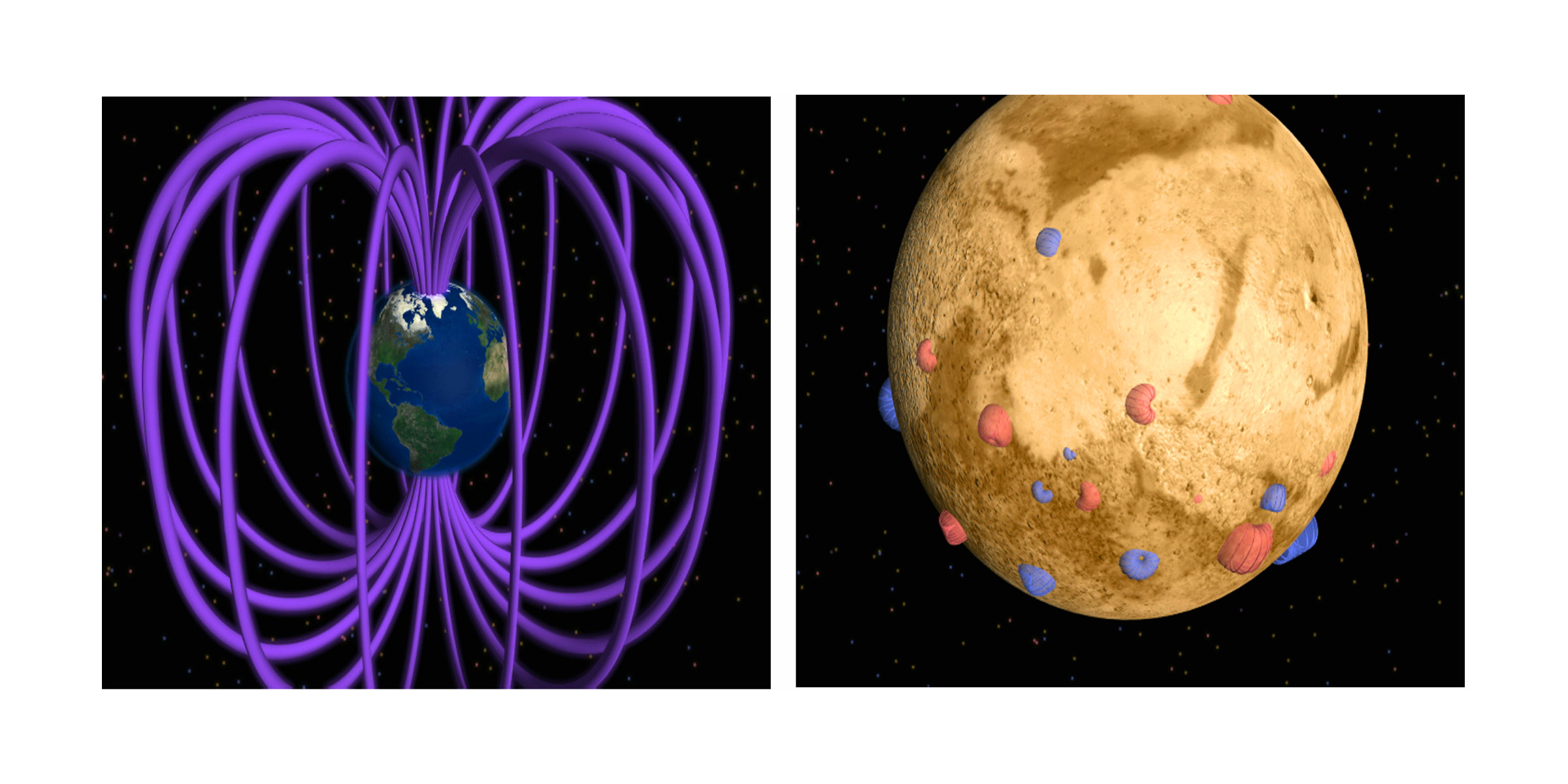
Caption: A cartoon comparing Earth's magnetic field and Mars's magnetic fields.
Earth's magnetic field is a global dipole field like a bar magnetic. It is believed to be caused by a dynamo effect of conducting liquid iron in the Earth's iron outer core.
Mars's iron core may no longer be liquid even in part. In any case, it is NOT generating a global field. There are small local fields due to permanently magnetized rock????. These are fossil magnetic fields.
Credit/Permission: NASA, Mario Acuna, Jack Connerney, Chris Meaney, 1999 / Public domain.
Download site: Views of the Solar System by Calvin J. Hamilton
Image link: Itself.
The Earth's magnetic field protects the Earth's atmosphere from the blasting effect of the solar wind: i.e., solar wind sputtering atmospheric escape The solar wind tends to blow away an exposed atmosphere.
The lack of strong global magnetic field means that the Martian atmosphere is directly exposed to the solar wind (see Wikipedia: Martian atmosphere: History). This seems to be a major factor Mars evolving to have a very low the density atmosphere compared to Earth's atmosphere. The average atmosphere pressure on the Martian surface is about 0.006 that of the average atmosphere pressure at Earth's sea level. Roughly speaking the Martian atmosphere is 100 times thinner than the Earth's atmosphere.
However, the low gravity of Mars (about 0.4 of Earth) and thermal atmospheric escape is probably the main reason for the relatively thin Martian atmosphere.
For more on atmospheric escape, see the figure below (local link / general link: solar_system_atmospheric_escape.html).
- The Martian Moons:
Just some basic Mars facts---which, of course, beg for an explanation---and there is some explanation, but also some "Just So."
-
Group Activity:
Form groups of 2 or 3---NOT more---and tackle Homework 14 problems 2--7 on Mars.
Discuss each problem and come to a group answer.
Oh, 5--10 minutes.
See Solutions 14.
The winners get chocolates.
- Mars Geography
- All Mars Maps:
As a first glance at Martian geography, see the two Mars maps in the figure below (local link / general link: nasa_mars_map_000.html).
- The Western Hemisphere of Mars:
The western hemisphere of Mars is shown the figure below (local link / general link: mars_full.html).
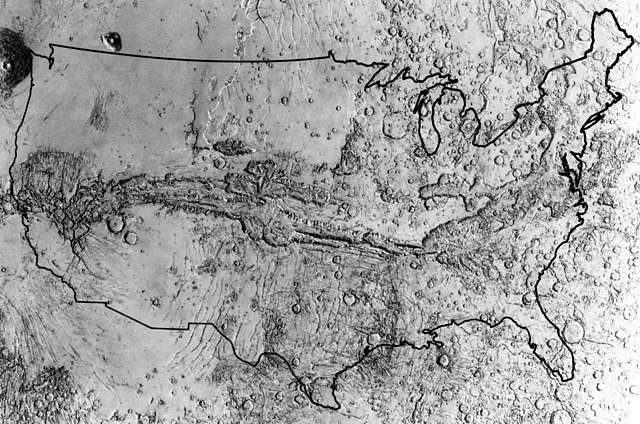
Caption: "Valles Marineris would stretch entirely across the United States---a distance of about 5,000 km."
Valles Marineris dwarfs the Grand Canyon.
Credit/Permission: © Stephen Paul Meszaros for NASA, 2009 / Creative Commons CC BY-SA 2.0.
Image link: Wikimedia Commons: File:Valles Marineris and the US -2 (4081334740).jpg.
- A Topographic Map of Mars:
.The collage-image map (see figure above: local link / general link: nasa_mars_map_000.html) and western hemisphere image (see figure above: local link / general link: mars_full.html) do NOT directly reveal the strong distinctions between the northern and southern hemispheres of Mars, except for more cratering in the southern one.
A topographic map reveals the elevation distinction. See the figure below.
-
For geographic feature names,
see
general link: nasa_mars_map_000.html
or, more directly,
nasa_mars_map_002.jpg---but
you need to magnify the image to see the names clearly.
- Note the southern hemisphere is generally higher than the northern
hemisphere. The southern hemisphere is believed to be 2--4 Gyr
and consists of ancient, heavily cratered plains.
- The northern hemisphere covered by younger lava flows,
perhaps, on
average 1 Gyr old
(HI-189).
- Note that the Tharsis region
is the highest region on Mars.
- Hellas Planitia,
a probable impact basin flooded by
lava, is
one of the lowest regions on Mars
and clearly the lowest in the southern hemisphere
(HI-185) .
- The "wry smile" of
Valles Marineris is
clear on the east side of
the Tharsis region.
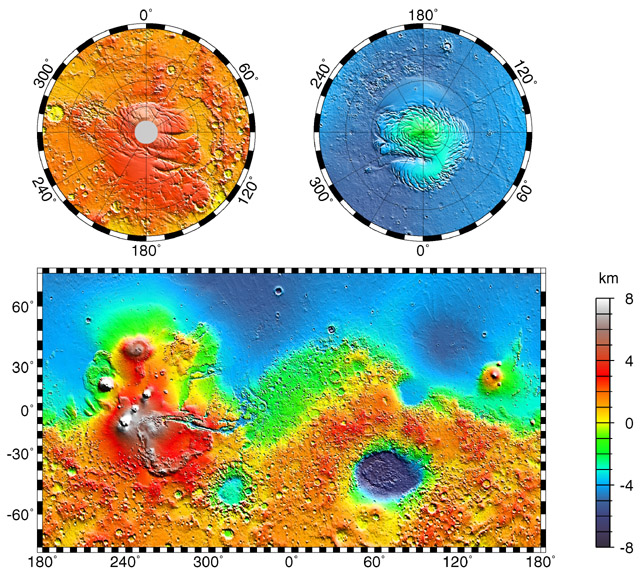
Caption: A Mercator projection cum conic projection physical map (also a topographic map) of Mars showing elevation by a color scale.
Features:
Download site: Views of the Solar System by Calvin J. Hamilton
Image link: Itself.
- The Western Hemisphere of Mars:
- Mars Geology, Except for Water Geology
-
Nowadays there's just too much known about the Martian geology.
- Mars in the Middle:
Because of its intermediate size between Earth and the Moon, we expect Mars to be intermediate in geological drivers.
Recall the bigger the rocky body, the more primordial-radiogenic heat geology it has (see also Wikipedia: Earth's internal heat budget: Radiogenic heat: Primordial heat).
-
Note all the rocky bodies
rocky-icy bodies
have the same abundances long-lived slow-heat-energy
generating radioactive isotopes
as the Earth to order of magnitude or so.
However, the smaller the rocky body or rocky-icy body, the faster heat conduction releases the heat energy to outer space and this lowers its power to drive primordial-radiogenic heat geology (see also Wikipedia: Earth's internal heat budget: Radiogenic heat: Primordial heat).
For more explication, see figure below (local link / general link: radiogenic_heat.html).
Mars is in the middle in size---about 1/10 of the Earth in mass, but about 8 times the Moon. So Mars has some primordial-radiogenic heat geology: much less than Earth and Venus, but a lot more than the Moon.
Also like Earth and Venus, Mars' primordial-radiogenic heat geology has been slowing down since the Formation of the Solar System 4.6 Gyr ago.
- The Geological Evolution of Mars:
Like Earth and the Moon, just after formation, Mars 4.6 Gyr ago went through chemical differentiation and cratering under the heavy bombardment and probably had massive lava flows in giant basins---any trace of this on Earth has been erased if it ever happened. Then continuing geological activity.
The 4 stages of evolution just mentioned (Se-427) are summarized in the cartoon in the figure below (local link / general link: rocky_body_evolution_4_stages.html).
Mars retains a lot of the impact craters, probably many??? from the heavy bombardment (circa 4.6--3.8 Gyr ago) in the southern hemisphere. See the topographic map of Mars below.
Hellas Planitia in the southern hemisphere may be a remnant of the early lava flooding of an impact basin (HI-185). So it may be a sort of a lunar mare---but on Mars.
The northern hemisphere is much less cratered and probably impact craters there are from after the heavy bombardment, but still relatively long ago. The northern hemisphere seems to have been resurfaced by lava flows.
So water erosion has also been much less important on Mars than on Earth. This is another reason for the surface of to be generally much older than that of Earth, but still less old than that of the Moon.
Also, it was once thought (circa 2005) that primordial-radiogenic heat geology was actively melting water ice periodically to the present day. But this is now doubtful. There may have been no flowing liquid water on Mars for a long time. Nothing is settled on this issue. See the section Water on Mars below.
-
Occasionally, Earth
has had significant impact event like the
dinosaurcidal
Cretaceous-Tertiary (K-T) extinction event (66 Myr BP).
A big deal for the dinosaurs---for geology NOT so much.
The Moon has pretty much lost its primordial-radiogenic heat geology and slowly evolves mainly due to impacts and space weathering.
So Mars' volcanism has been slowing down, but unlike that of the Moon and other small rocky body without tidal-flexing-heating geology, Mars still has slightly active volcanoes it is thought. We take up the subject of Mars' volcanism in the next subsection.
- Volcanoes on Mars:
: The image is public domain, but CJH does NOT give a download site.Mars has volcanoes most notably the four big ones of the Tharsis region.
The biggest of the four and biggest known in the Solar System, in fact, is Olympus Mons---see the figure below.
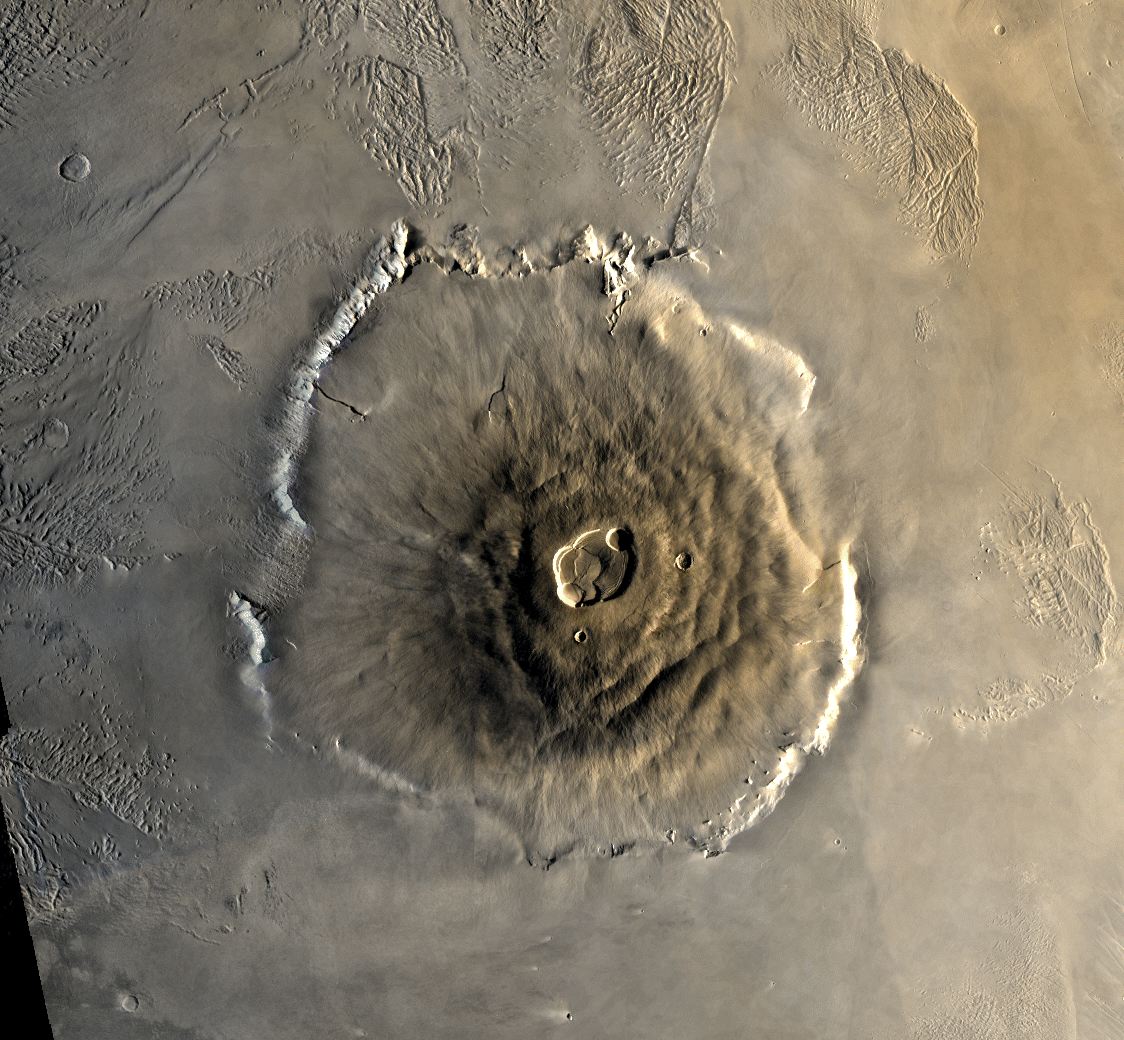
Caption: Olympus Mons in the Tharsis region of Mars.
This is an approximately true-color mosaic image from Viking Orbiter 1 (1975--1976-arrival--1980) from 1978 Jun22.
Olympus Mons is the largest known volcano in the solar system.
It is a shield volcano with shallow slopes of 2° grade to 5° grade. You could walk up it.
-
Hawaiian Islands
are the tops of shield volcanoes
that formed over the Hawaii hotspot.
Mount Kilimanjaro, on the other hand, is a stratovolcano. But you can just walk/hike up Mount Kilimanjaro---don't wait till there's no glaciers left (see Wikipedia: Mount Kilimanjaro: Glaciers).
The base of Olympus Mons is about 500 km across, the height above the lower deserts is 24 km, and the summit caldera is about 65 km across (HI-190).
Olympus Mons covers an area about equal to that of Arizona.
Credit/Permission: NASA, NASA: NSSDC Photo Gallery Mars, 1978 / Public domain.
Image link: Itself.
Olympus Mons is a shield volcano. See cartoon of a shield volcano in the figure below (local link / general link: volcano_shield_cartoon.html).
Shield volcanoes occur on Venus, Earth, and Mars.
Another image of Olympus Mons in shown in the figure below.
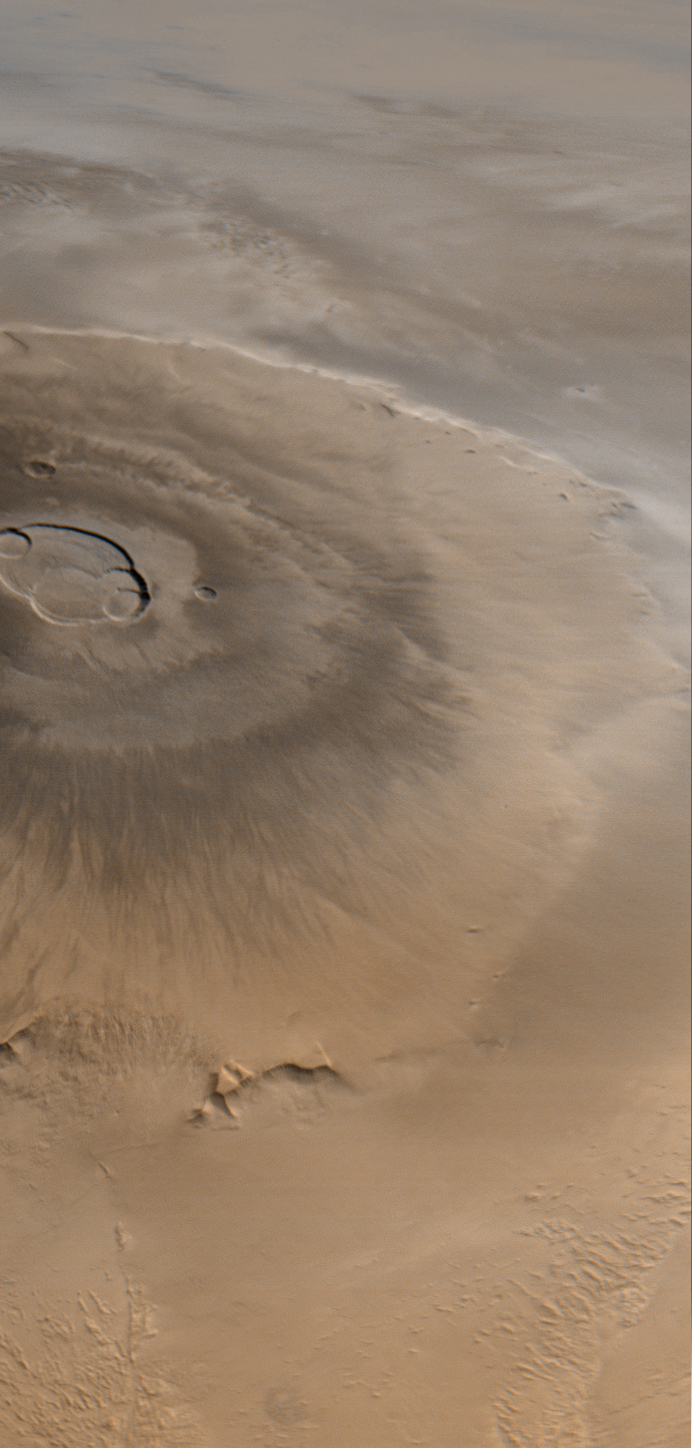
Caption: Olympus Mons in the Tharsis region of Mars.
This is Mars Orbital Camera (MOC) approximately true color image from 1998apr25.
Olympus Mons is the largest known volcano in the Solar System.
It is a shield volcano with shallow slopes of 2° to 5° grade. You could walk up it The base is about 500 km across, the height above the lower deserts is 24 km, and the summit caldera is about 65 km across (HI-190).
-
Calderas on
Earth anyway form when a chamber near the summit
is partially emptied by the outflow of lava and ash collapse
to form a broad flatish depression with steep walls
(SWT-573).
The clouds are water ice clouds (such as we have on Earth) I think (FMW-200--201).
There are also dust clouds and carbon dioxide (CO_2) ice clouds, but the former might look dustier and the latter are supposed to be high altitude whatever that means for Mars.
Anyway water ice clouds are supposed to often form near mountains.
Credit/Permission: NASA, Malin Space Science Systems, 1998 / Public domain.
Download site: Views of the Solar System by Calvin J. Hamilton
Image link: Itself.
See the video Vuela sobre el monte Olympus de Marte | 0:1:55 (an animation of a flight over Olympus Mons) in Mars videos below (local link / general link: mars_videos.html):
- EOF
- Mars Lives---Geologically Speaking:
It was once thought that Mars's primordial-radiogenic heat geology was dead, like the Moon's---but only more recently deceased.
But now there are lava flows judged to be less than 100 Myr old from crater counts (HI-189).
Less than 100 Myr is almost nothing on the time-scale of internal heat loss for a Mars-size body.
Thus, Mars has primordial-radiogenic heat geology and volcanism today---although at a much lower level of activity than Earth or Venus.
Of course, we may have to wait millennia or millions of year for the next volcanic eruption.
-
On Earth, there's a good eruption every few years:
- Mount Vesuvius 79 CE, Pompeii, Italy.
- Mount Tambora eruption 1815, Indonesia.
- Krakatoa eruption of 1883, Indonesia.
- Mount St. Helens eruption 1980, United States of America. See the figure below.
- Mount Pinatubo eruption 1991, Philippines.
- Soufriere Hills eruption 1995--1999, Montserrat.
- Eyjafjallajoekull eruption of 2010, Iceland.
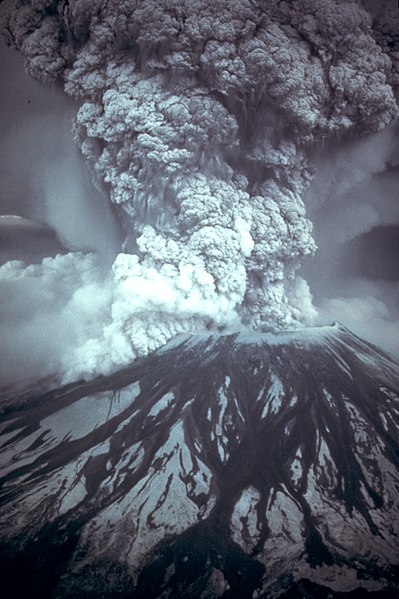
Caption: "On May 18, 1980, at 8:32 a.m. Pacific Daylight Time, a magnitude 5.1 earthquake shook Mount St. Helens. The bulge and surrounding area slid away in a gigantic rockslide and debris avalanche, releasing pressure, and triggering a major pumice and ash eruption of the volcano. Thirteen-hundred feet (400 meters) of the peak collapsed or blew outwards. As a result, 24 square miles (62 square kilometers) of valley was filled by a debris avalanche, 250 square miles (650 square kilometers) of recreation, timber, and private lands were damaged by a lateral blast, and an estimated 200 million cubic yards (150 million cubic meters) of material was deposited directly by lahars (volcanic mudflows) into the river channels. Sixty-one people were killed or are still missing. USGS Photograph taken on May 18, 1980, by Austin Post."
Double-click for high resolution image.
Credit/Permission: US Geological Survey (USGS), 1980 / Public domain. See USGS Copyright Policy.
Image link: Wikipedia: File:MSH80 eruption mount st helens 05-18-80.jpg.
See Volcano videos below (local link / general link: volcano_videos.html):
- Plate Tectonics on Mars?
Does Mars have plate tectonics?
Apparently, NOT.
There is no solid evidence for divergent boundaries or convergent boundaries.
It is theorized that Valles Marineris (see below local link: mars_videos.html) is large rift valley where the Martian crust is being pulled apart (see Wikipedia: Valles Marineris: Formation). On Earth, rift valleys can be divergent boundaries between tectonic plates (see Wikipedia: Rift valley), but Valles Marineris does NOT seem to fall into that class.
Valles Marineris may be plate-tectonics feature of Martian plate tectonics that never developed very far.
There are no real continent or terra formations. (Terras are the continent-like features on Venus.)
Volcanism on Mars may be all hotspot volcanism. The Tharsis region may have been formed by a giant hotspot and may be similar to the coronas on Venus (HI-191).
See Valles Marineris in Mars videos below (local link / general link: mars_videos.html):
- EOF
- The Future of Mars:
In the future, of course, primordial-radiogenic heat geology must slow on Mars as primordial heat from formation and past radioactive decay decreases. It must turn off eventually.
But probably this won't happen until long after the Sun becomes a white dwarf.
Mars probably won't be vaporized in the Sun's red giant and AGB phases and may continue to orbit the white dwarf Sun in some orbit for hundreds of gigayears into the future????.
The orbit of Mars will certainly be different in that far future since the Sun will lose a lot of mass in becoming a white dwarf, and thus its gravitational force will be weakened. Probably the orbit will be much larger.
- The Geological Evolution of Mars:
Too much for us.
So we'll skim.
- The Martian Atmosphere
-
The Martian atmosphere
is thin.
- The Thinness of the Martian Atmosphere:
The Martian atmosphere is shown in the figure below.
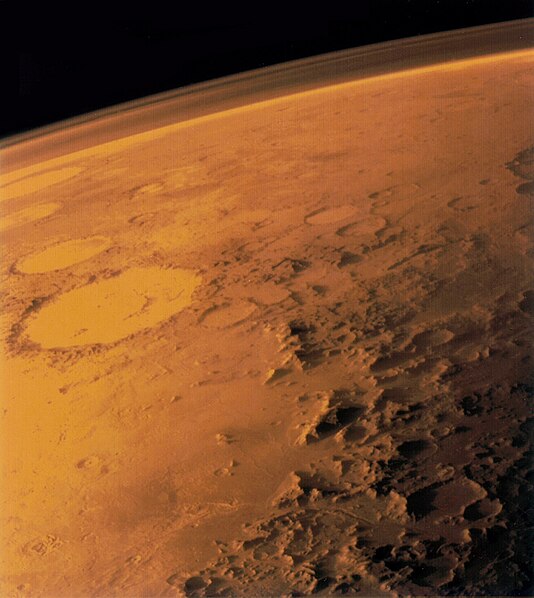
Caption: The Martian atmosphere seen on the limb of Mars from the low-orbit Viking orbiter.
Crater Galle---the happy face crater---is on the left.
Credit/Permission: NASA, 1976 (uploaded to Wikipedia by User:Keta, 2006) / Public domain.
Image link: Wikipedia: File:Mars atmosphere.jpg.
The surface pressure that is about 1 % of Earth's.
-
More precisely, the average atmosphere pressure on the
Martian surface
is about 0.006 that of the average atmosphere pressure at
Earth's
sea level.
The Martian pressure varies with weather, season, and altitude, of course (HI-187).
Recall gas pressure is due to the motion of free-flying gas atoms and molecules. For illustration of how pressure arises, see the animation in the figure below (local link / general link: gas_animation.html).
- The Existence of Liquid Water on Mars:
The low pressure of the Martian atmosphere means that liquid water CANNOT exist on the surface for any length of time.
Under low enough pressure, the liquid phase doesn't occur for most (all?) substances: they condense from gas to solid and vaporize (in loose astro jargon) from solid to gas.
The figure below (local link / general link: co2_ice.html) gives an example of a substance that under standard temperature and pressure (STP) has NO liquid phase.
Qualification: The liquid phase doesn't exist in thermodynamic equilibrium if the pressure is too low. If you suddenly inject the liquid into a low pressure environment, it is out of the thermodynamic equilibrium and will persist as liquid for some time---how long depends on the conditions---which for Mars, yours truly doesn't know.
It may be that on the warmest days on the Martian equator or in the Martian summer hemisphere in the deepest valleys that liquid water could persist---but there's no evidence that there is any under such conditions.
- The Composition of the Martian Atmosphere:
The Martian atmosphere is CO_2 dominated like the atmosphere of Venus---but there is VERY LITTLE greenhouse effect because of the low density.
The table below shows the composition of the Martian atmosphere.
Table: Martian Atmospheric Composition by Number _______________________________________________________________________ Gas Percentage (%) _______________________________________________________________________ CO_2 95 N_2 2.7 Ar 1.6 CO 0.6 H_2O 0.03 variable due to condensation & vaporization from solid phase ______________________________________________________________________References: HI-187.
There is some water vapor which can condense in the air to make white water ice clouds as we maybe??? saw with the Olympus Mons picture above.CO_2 ice clouds can make clouds at high altitudes too (FMW-200--201).
Probably early on, Mars had a significant CO_2 and water vapor atmosphere from volcanic outgassing like the early Earth and early Venus are thought to have had.
-
There is a theory that comets brought significant
volatile
material, particularly water,
to the Earth in some early phase---"a hard rain fell".
If this was so for the early Earth, then it is also likely so for the early Mars.
The theory has had its ups and downs in acceptance.
At present, theory that comets from the Kuiper belt brought most water to Earth seems to be gaining ground.
We won't discuss the hard comet rain theory further for Mars---but it should be kept in mind.
But because of the low gravity of Mars and probably solar wind in the absence of a global magnetic field, much of this early thick Martian atmosphere has undergone atmospheric escape over the gigayears.
The fractionation of the argon isotopes in the Martian atmosphere provides direct evidence of atmospheric escape. See the figure below.
Probably the molecules of CO_2 and H_2O were broken up at high altitudes and the C and H escaped mostly.????
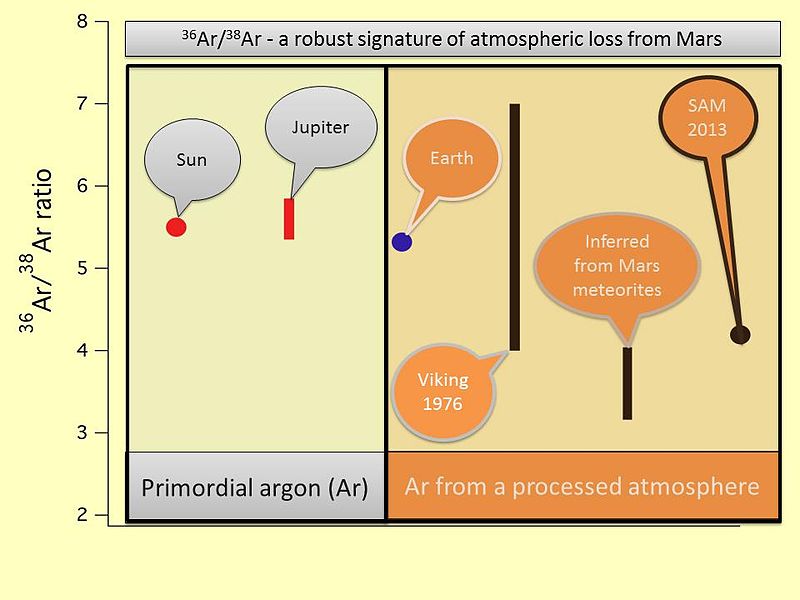
Caption: "Image PIA16818: argon isotopes provide strong evidence of atmospheric escape from Mars.
This image shows the ratio of the argon (Ar) isotope Ar-36 to the heavier isotope Ar Ar-38 in various measurements. The point farthest to the left designates a new (2013) measurement of the ratio in the Martian atmosphere made by the quadrupole mass spectrometer in the Sample Analysis at Mars (SAM) suite of instruments in NASA's Curiosity Mars rover (Mars Science Laboratory mission).
For comparison, the previous measurement from Mars by the Mars Viking project in 1976 is shown also. The SAM result is at the lower end of the range of uncertainty of the Viking data, but compares well with ratios of argon isotopes from some Martian meteorites.
The value determined by SAM is significantly lower than the value for the Sun, Jupiter, and Earth which implies loss of the lighter isotope (Ar-36) compared to the heavier isotope (Ar-38) over geologic time.
The fractionation of the argon isotopes provides clear evidence of the atmospheric escape from Mars." (Moderately edited.)
To be brief: there has been atmospheric escape since there has been preferential atmospheric escape of the lighter isotope Ar-36.
To elaborate: Based on the argon abundance, it has been argued that Mars probably once had an atmosphere that was comparable in density to the Earth's current atmospheric density (HI-192).
Argon is a much heavier particle (standard atomic mass 39.948(1)) than carbon (standard atomic mass 12.0107(8)) and oxygen (standard atomic mass 15.9994(3)).
The heavier the mass, the harder it is for the atom to escape to space.
Image link: Wikipedia: File:PIA16818-MarsCuriosityRover-Argon-AtmosphericLoss.jpg.
- O_2 on Mars:
: The image is public domain, but CJH does NOT to give a download site.Any oxygen in the form of O_2 did NOT stay, and there may never have been much build of it in the Martian atmosphere if Mars never had biological production.
-
O_2 is highly reactive and reacts with minerals to form solid oxides
most notably iron(III) oxide or ferric oxide (Fe_2O_3)
which mixed with other iron oxides
and water molecules gives
rust.
See How does rust work?
and
Wikipedia: Rust.
-
The
iron oxide
of Mars may have formed
during the condensation and/or early formation stage of the planet and NOT from iron reacting
with atmospheric O_2.
This iron oxide then survived the molten phase of the planet.
On Earth, temperatures were higher in the molten phase and iron oxide may have dissociated at great depths with more iron sinking to the core.
Any abundant iron oxide left on the very surface would have been subducted and spread thin in subsequent surface renewal????.
See Rubie, D. C., Gessmann, C. K., & Frost, D. J. 2004, Nature, 429, 58.

Caption: The terrain around the Pathfinder landing site. 1997dec.
Pathfinder was the first lander since the Viking 1 and 2 landers in the 1976. It landed in 1997 (HI-183--184).
The image is a 360° panorama.
In order to study the surroundings in detail with the SOJOURNER ROVER (near Yogi at 320° in the image), it was necessary to map the landscape.
For mnemonic reasons names were given to quite small features: names were evidently derived from a variety of pop-cultural sources.
As one can see the sand is reddish and so are some of the rocks. The red color is due to iron oxide and is typical of Mars (PF-118).
Mars is the Red Planet after all.
Credit/Permission: NASA, US Geological Survey (USGS), 1997 / Public domain.
Download site: Views of the Solar System by Calvin J. Hamilton
Image link: Itself.
- The Colors of Mars:
Actually Mars's colors are tricky.
From Earth, it looks reddish-orange with the naked eye??? (PF-118).
-
This coloration may well have been the original reason associateing
war gods
as mentioned in the Introduction.
Close up orbiter images often show the bright areas as more yellowy-browny than red.
The reddish surface, as discussed above, is because of the high amount of iron(III) oxide (Fe_2O_4) (see Wikipedia: Martian surface: Albedo and Color).
The dark or blackish regions (like Syrtis Major) are because of a high amount of iron(II) oxide or ferrous oxide (FeO) Wikipedia: Martian surface: Albedo and Color.
Then there is the problem of the Martian sky color.
Images typically use filters to bring out features, NOT show true color as seen by the human eye.
The Martian sky color does vary, but the daytime color seems to be mainly a bright yellow-brown. See the figure below.
Near sunrise and sunset the color is mainly rose, but just near the Sun the color is blue.

Caption: "The Martian sky color at noon is yellow-brown, which contrasts with its pinkish-red color at sunset. The true color of Mars based upon three filters with the sky set to a luminance of 60. The color of the Pathfinder landing site is yellowish brown with only subtle variations. These colors are identical to the measured colors of the Viking landing sites reported by Huck et al. [1977]. This image was taken near local noon on Sol 10. A description of the techniques used to generate this color image from IMP data can be found in Maki et al., 1999. Note: a calibrated output device is required accurately reproduce the correct colors."
Credit/Permission: NASA, 1999 (uploaded to Wikipedia by User:Liftan, 2007) / Public domain.
Image link: Wikipedia: File:Mars sky at noon PIA01546.jpg.
- Climate on Mars:
Because of its low pressure and hence lack of liquid water, Mars today is essentially a cold desert.
-
Recall from above that summer day time temperatures in the air
only get up to about -30 C.
- Seasons on Mars:
The Martian seasons somewhat mimic Earth's and are most noted through the variations in the Martian polar ice caps. See the figure below.
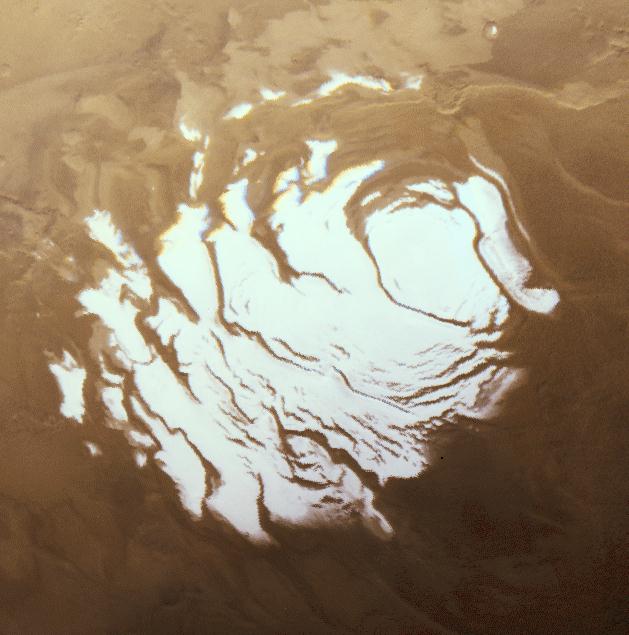
Caption: A Viking orbiter image of the south polar cap of Mars in the Martian southern summer.
The south polar cap is about 400 km across in this image and this is its residual summer size (i.e., about as small as it gets).
The south polar cap has a fragmented, layered appearance.
The north polar cap has a larger residual size of 1000 km across (FMW-201).
Because it is mid-summer, the pole is in constant daylight with the night side of Mars see at the bottom of the image.
The polar caps consist of water ice perhaps up to several kilometers thick covered by a layer of CO_2 ice (dry ice) that may be centimeters to several meters in thickness (HI-188).
Both kinds of ice tend to be white when they have a rough surface.
The water ice never evaporates much, but much of the CO_2 ice evaporates with the summer and condenses again in the winter.
-
Actually, sublimation
is the specific technical term for a
solid to
gas
phase transition.
But in astro jargon, we just say evaporates---the solid turns into a gas---it clearly evaporates.
Credit/Permission: NASA, 1976--1980 / Public domain.
Download site: Views of the Solar System: Mars by Calvin J. Hamilton.
Image link: Itself.
The Martian polar caps are coated in a layer CO_2 ice (dry ice) over a much thicker layer of water ice.
In a Martian summer hemisphere, some of the CO_2 evaporates (properly speaking sublimates) and goes into the Martian atmosphere. So the summer Martian polar cap shrinks.
At the same time, the winter Martian polar cap in the other Martian hemisphere (the winter hemisphere) grows as CO_2 from the Martian atmosphere condences (properly speaking deposits) on it.
So the north polar cap and south polar cap alternatively grow and shrink with the Martian seasons.
The figure below shows a simplified version of the behavior of Martian volatiles which implies the seasonal cycle of the Martian polar caps.
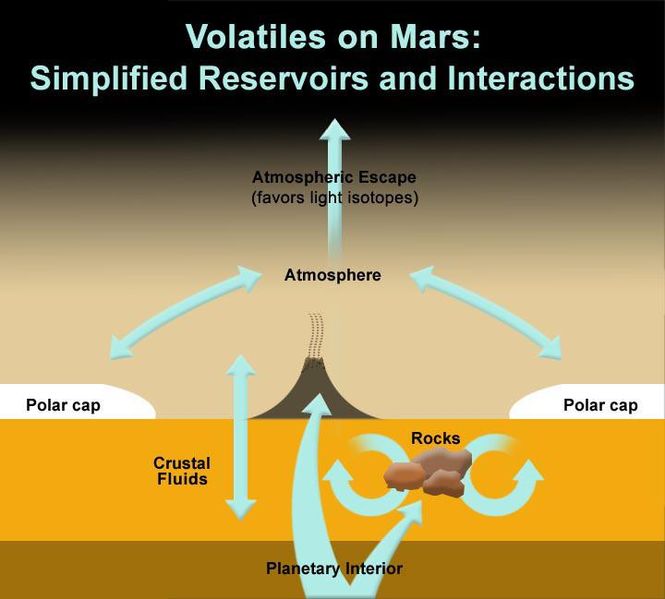
Caption: "Volatiles on Mars. This illustration shows the locations and interactions of volatiles on Mars Volatiles are substances that readily evaporate, converting to their gaseous form (e.g., water and carbon dioxide (CO_2). On Mars, and other planets, these substances are released from the crust and planetary interior into the atmosphere via volcanic plumes. On Mars, significant amounts of CO_2 go back and forth between Martian polar ice caps and the Martian atmosphere depending on the season---when it's colder the CO_2 gas condences onto the polar ice caps---when it's hotter it evaporates." (Moderately edited.)
Credit/Permission: NASA/Jet Propulsion Laboratory (JPL)-Caltech, 2012 (uploaded to Wikipedia by User:Drbogdan, 2012) / Public domain.
Image link: Wikipedia: File:PIA16463-MarsVolatiles-20121102.jpg.
Besides the Martian polar cap, CO_2 gas condences at other places on Mars too as a CO_2 frost as illustrated in the figure below.
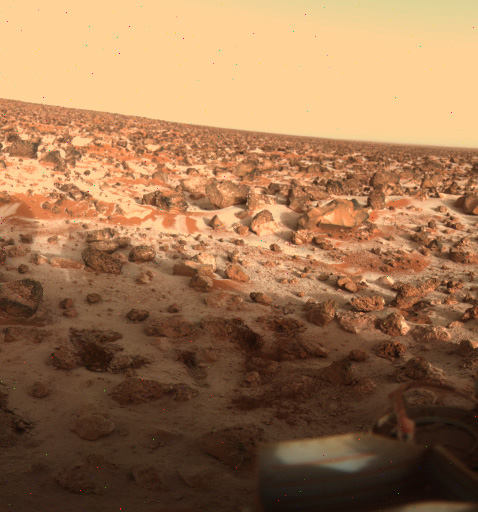
Caption: The terrain around the Viking 2 Lander site, 1979, May18.
The Viking 2 Lander was in the northern/eastern hemisphere Utopia Planitia lava plain.
It landed 1979 Sep03 (HI-184), and so must have operated a long time.
The time of the image is the northern winter???.
The image is true color. The red rock and dust is due to iron oxide mineral content.
Whitish covering is CO_2 frost. It is thought that Martian dust grains covered with a bit of water ice serve as condensation sites for CO_2.
When it gets cold enough (below 150 K: FMW-201), the CO_2 condenses out on the grains and the grains fall to the ground.
Credit/Permission: NASA, 1979 / Public domain.
Download site: NASA: image #P-21873.
Image link: Itself.
- Weather on Mars:
The weather on Mars is most notable through the winds blowing Martian dust and dust storms.
These dust storms can be global, but I've never seen an image where it was easy for me to notice that a dust storm was happening---it must take a trained eye.
A smaller Martian dust phenomena are the Martian dust devils.
Dust devils are little whirlwinds which we have on Earth too including in Arizona and Nevada---there was one in my parking lot once. See the figure below.
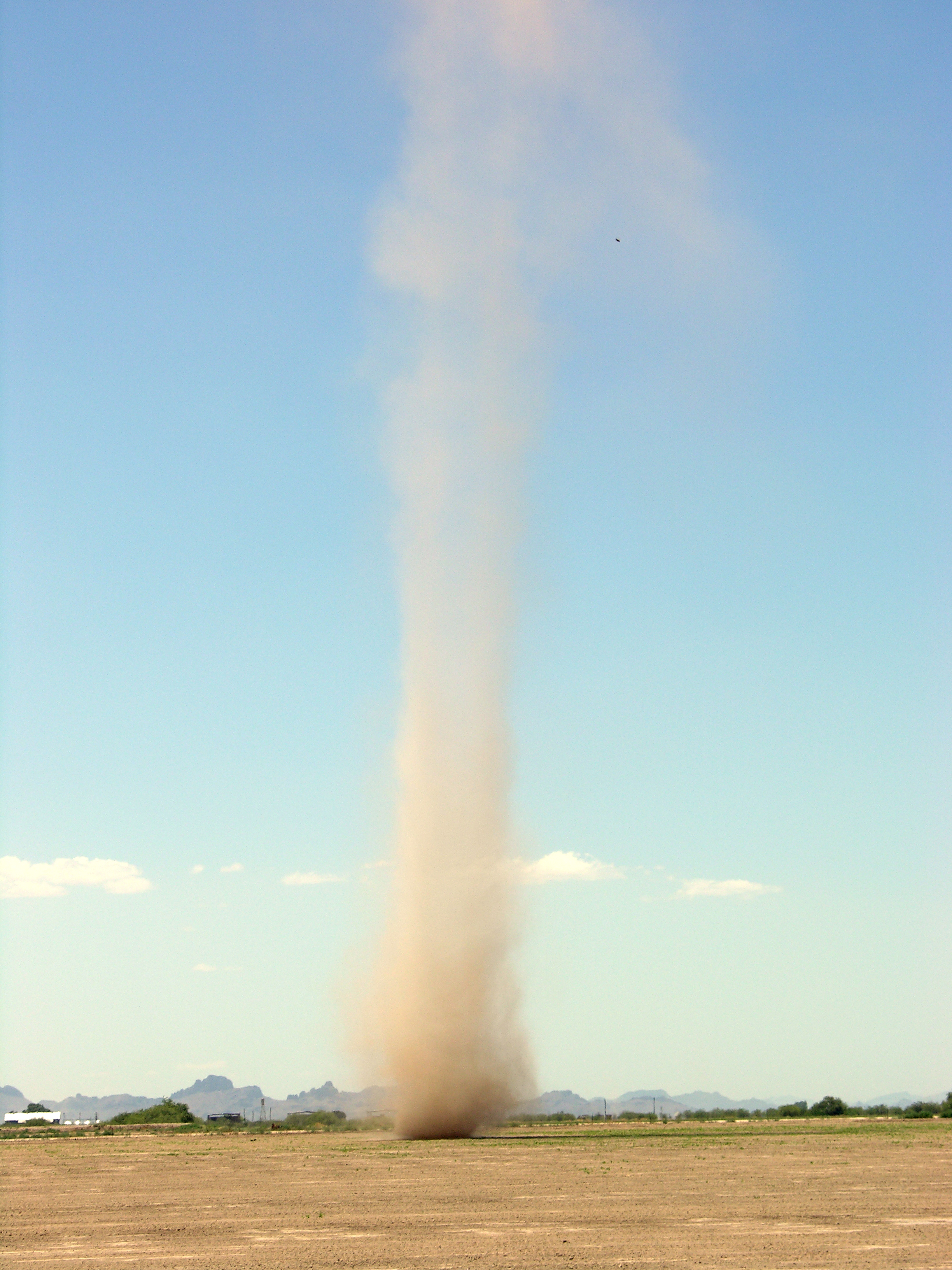
Caption: "A dust devil in Arizona."
-
A dust devil is a strong,
well-formed, and relatively long-lived whirlwind,
ranging from small (half a meter wide and a few meters tall) to large
(more than 10 meters wide and more than 1000 meters tall). The primary vertical motion is upward.
There are Martian dust devils---made of Martian dust.
Credit/Permission: NASA, 2005 (uploaded to Wikimedia Commons by User:Walterince, 2008) / Public domain.
Image link: Wikimedia Commons: File:Dust devil.jpg.
See Martian dust devils in Mars videos below (local link / general link: mars_videos.html):
- EOF

Caption: Barchans in the Hellespontus Montes region of the Noachis quadrangle on Mars as imaged by Mars Reconnaissance Orbiter's HiRISE instrument.
The location is 41.4° south latitude and 315.4° west longitude. North is 187° clockwise from the vertical.
Barchans are well known terrestrial dunes. The horns point downwind.
And Barchans are also a form of Martian sand dune.
So Mars has dunes, but Mars is NOT Dune.
Credit/Permission: NASA, 2009 (uploaded to Wikimedia Commons by User:User:File Upload Bot (Magnus Manske), 2009) / Public domain.
Image link: Wikimedia Commons: File:Barchan in Noachis.jpg.
The Martian atmospheric dust is reddish in color (or yellowish-brown, but it's in the eye of the beholder) and its magnetic component is due to magnetite (iron oxide Fe_3O_4) (a black iron oxide) (see Kerr, R. A. 2005, Science, 308, apr08, 192).
Magnetite is NOT formed in water and that it is in the Martian dust suggests much of Mars has been mostly dry for a long time.
Martian dust and other evidence is pointing to Mars having had a dry surface for maybe 3.7 Gyr, except perhaps for brief episodes (see Kerr, R. A. 2005, Science, 308, apr08, 192).
- The Existence of Liquid Water on Mars:
-
Group Activity:
Form groups of 2 or 3---NOT more---and tackle Homework 14 problems 9--14 on Martian geology, etc.
Discuss each problem and come to a group answer.
Oh, 5--10 minutes.
See Solutions 14.
The winners get chocolates.
See Solutions 4.
- Water on Mars
-
The subject of water on Mars has
been heavily investigated.
- Liquid Water on the Surface of Mars:
There is significant Water on Mars---but there is no continuous liquid water on the surface.
-
Question: Why can't there be liquid water for any
length of time on the surface?
- It is too cold most of the time.
- The air pressure is too low for the liquid phase to exist in thermodynamic equilibrium.
Well both answers are sort of right.Actually, at the lowest surface points on Mars, the pressure is high enough that liquid water can exist in thermodynamic equilibrium in a narrow temperature range (Wikipedia: Water on Mars: Theoretical Issues). The pressure at these low points just barely reaches that of the triple point of water, 61173 Pa. Below this pressure liquid water in thermodynamic equilibrium is NOT possible. Just above this pressure, liquid water exists in a narrow temperature range near 273.16 K.
So if the lowest surface points had just the right temperature continuously, liquid water could persist there in thermodynamic equilibrium.
But those lowest surface points are never continuously warm enough.
So we CANNOT expect to find liquid water at those points very often and maybe never.
- A Catalog of Water on Mars:
Let's do a little catalog of water and possible water on Mars.
- In the atmosphere, there is about 0.03 % water vapor
by number as noted above.
This is much lower than the 0.1--2.8 % range on Earth (CW-296), and recall Earth's atmosphere is about 100 times denser than Mars's atmosphere.
-
There is water in the soil in the form of isolated molecules embedded in
the crystal structure of rock grains. This was discovered by
the Viking landers
(HI-188).
-
Recall Earth rock also contains
water up to 1 to 2 % by
number/weight???
But Moon rocks are extremely dry
(Se-451).
-
There is substantial water ice. The
polar caps as noted above probably
have 1 to 3 km of water ice in places
(HI-187).
-
Although NOT proven absolutely, it is considered highly likely that
there is water ice
in the soils at higher latitudes
(HI-188).
-
I'd like to say permafrost above,
but permafrost, apparently, means soil
below freezing for two or more years whether
water ice is present or NOT.
- At deep enough depths where pressure and temperature are sufficiently high, there
well may be liquid water
in aquifers
(HI-195).
- There is solid evidence now for
Martian glaciers
on that formed within millions
to tens of millions of years ago as one can tell by cratering
on them
(Kerr, R. A. 2005, Science, 308, apr08, 192).
One is at the base of Olympus Mons for example.
The glaciers are rock-and/or-dust-coated, and so hidden. It has taken detailed imaging by the NASA Mars Global Surveyor and the ESA Mars Express Orbiter (first operational 2004) and radar mapping by the NASA Mars Reconnaissance Orbiter to find their signatures.
They are NOT like most terrestrial glaciers, but rather like those in the McMurdo dry valleys in Antartica---they ooze over things rather than slide on a wet layer.
Caption: "Tributary Glacier in Ismenenius Lacus, as seen by hirise. Location is 41.3° north latitude and 54.7° east longitude. Image was taken by the Mars Reconnaissance Orbiter's HiRISE. The HiRISE camera was built by Ball Aerospace and Technology Corporation and is operated by the University of Arizona. Image courtesy NASA/JPL/University of Arizona."
Martian glaciers exist!
Credit/Permission: NASA, 2009 / Public domain.
Image link: Wikipedia: File:Tributary Glacier.JPG.
Probably the Martian glaciers formed from straight vapor to solid transitions. There was no liquid water involved.
They probably are NOT growing now, but are relics of a time when Mars's axial tilt was larger and more water could be sublimated from the polar caps and spread to other regions. The axial tilt seems to vary because of some effect???.
- Martian Gullies:
As noted in the section The Martian Atmosphere, liquid water CANNOT exist now on the surface for any length of time because of the low pressure and low temperature.
It can exist for short times before it evaporates or freezes.
But does it?
It's very uncertain.
In the last few years the Mars Global Surveyor's Mars Orbiter Camera (MOC) has been finding evidence of fairly recent gullies on Mars.
-
The Mars Global Surveyor
is an orbiter operational 1997--2006 and as well as
imaging produced detailed elevation information.
The topographic map above was constructed from
Mars Global Surveyor data.
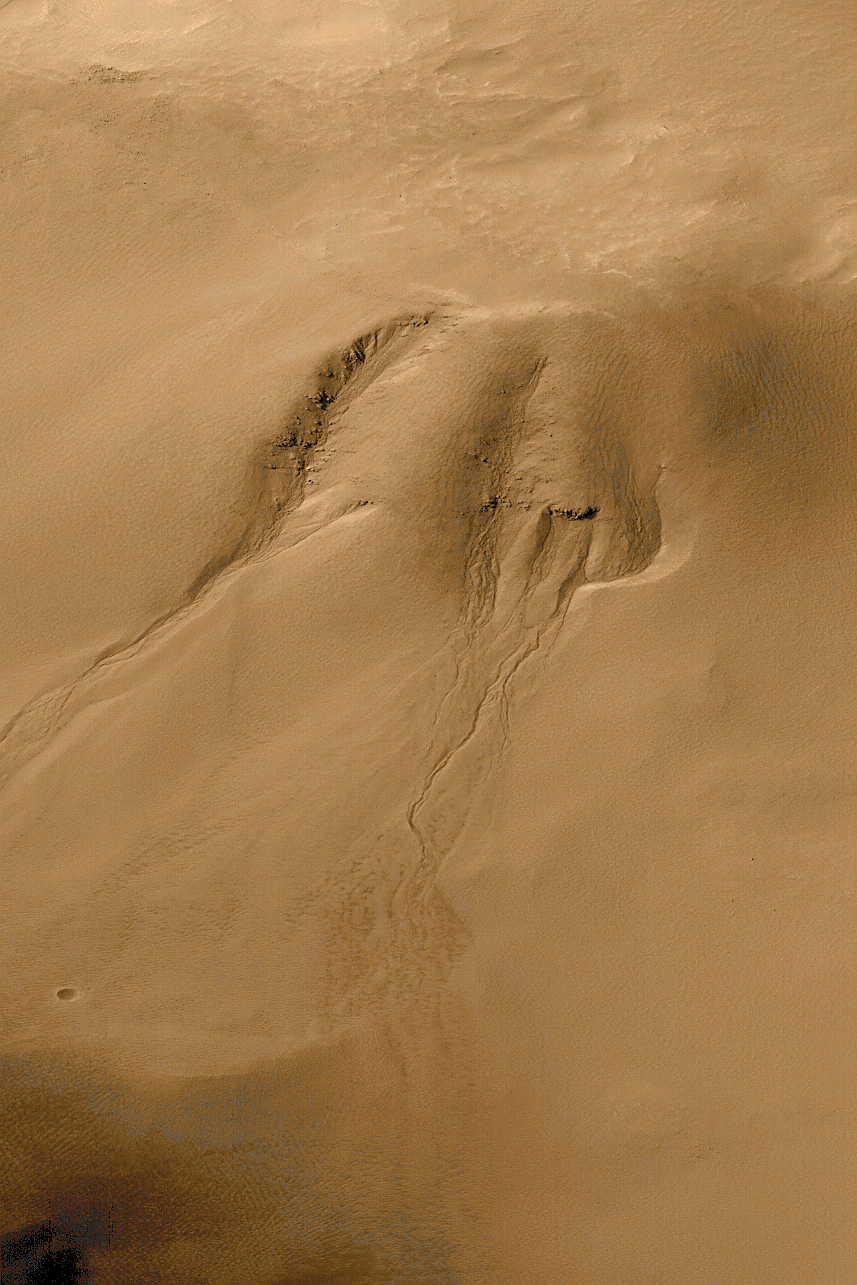
Caption: An approximately true color image of Martian gullies
The MOC image is from 1999sep28. The image is 9 x 6.7 km. We are viewing the south-facing inner rim of the crater. There is a sand dune on the crater floor. The location is 54.8 S, 342.5 W (or 17.5 E).
The gullies are eroded into the rim of impact Crater Noachis Terra. The image is an approximate true color, high resolution image from the Mars Global Surveyor's Mars Orbiter Camera (MOC).
One sees the channels and apron of debris.
These gullies suggest that there must have been groundwater seepage and surface runoff leading to the apron.
The feature is very similar to gullies seen in the American south-west.
There are no superimposed craters indicating that the gullies are geologically young. How young?
-
There is one little crater it seems near the bottom left,
but it isn't superimposed ont apron of sediment.
There may be liquid water in the Martian subsurface today.
Other images suggest water seepage within tens of years which is the same as saying it is ongoing (Views of the Solar System by Calvin J. Hamilton.
Mars's atmosphere is too rarefied to allow liquid water to exist in thermodynamic equilibrium. Only the solid and gas phases of water can persist.
Perhaps the liquid water in the subsurface is sometimes squeezed to the surface by a sudden geothermal event or an impact could melt water ice near the surface.
If something like that happened, water could flow for awhile until it evaporated or froze.
But this was all thought circa 2005.
It may still be true, but nowadays such small gullies are known to form without water just by flowing sand or regolith.
Similar gully-like features are now seen on the Moon and they are certainly dry lunar soil features.
See Gwendolyn D. Bart, 2007, Icarus, April, Comparison of Small Lunar Landslides and Martian Gullies. Gwen Bart is an old friend of yours truly at University of Idaho (UI).
Credit/Permission: NASA, JPL, Malin Space Science Systems, 2000 / Public domain.
Download site: Malin Space Science Systems: Mars Global Surveyor: Mars Orbiter Camera. Download site alternative: Views of the Solar System by Calvin J. Hamilton.
Image link: Itself.
Where is the liquid water---if there is any on the surface ever---coming from?
Well you don't need to go far down into the ground before the pressure rises high enough for liquid water to exist.
Since we argued above that Mars has still modest internal heat, at some depth beneath the ground it is probably warm enough as well as high enough in pressure for liquid water.
Thus, it's possible, as noted above, that underground water reservoirs (i.e., aquifers) exist today (HI-195).
Subsurface events may sometimes squeeze liquid water to the surface where it flows out of canyon or crater walls and forms gullies in the brief time before it evaporates or freezes.
-
I imagine that water ice, except near the poles, likely sublimes quickly
in the summer weather.
a recent theory says the "gullies" may be slumping of the powdery surface, and thus a purely dry phenomenon. See Nature: Shinbrot et al. Just when you think you understand something, some crazy scientist comes along and ...
There has been a nugget of evidence from chemical deposits for the presence of liquid water on maybe a yearly or millennial basis, but it's NOT very exciting (Nature: Liquid Water Found on Mars, But It's Still a Hard Road for Life, 2010oct29). In any case, it's NOT on the surface, but below CO_2 ice layers.
- A Wetter Mars in the Past:
Was Mars wetter in the past? Did it have continuous surface water?
Well ever since the Viking orbiters of the 1970s these questions have been hotly debated.
Images from the Viking orbiters showed many striking channel features---dry of course.
Some of them may be flood channels due to a sudden melting of water ice and release of liquid water by a volcanic eruption or an impactor.
But some channels look very much like rain-fed runoff channels such as we find on Earth.
-
Question: What do extensive rain-fed
runoff
channels look like on
Earth as viewed from above?
- Like parallel straight lines.
- They form a dendritic (i.e., tree-branching) pattern.
Answer 2 is right.For rain and surface liquid water to exist, Mars's atmosphere would have had to have been substantially denser and warmer than today.
There is evidence for this as discussed in the figure below.
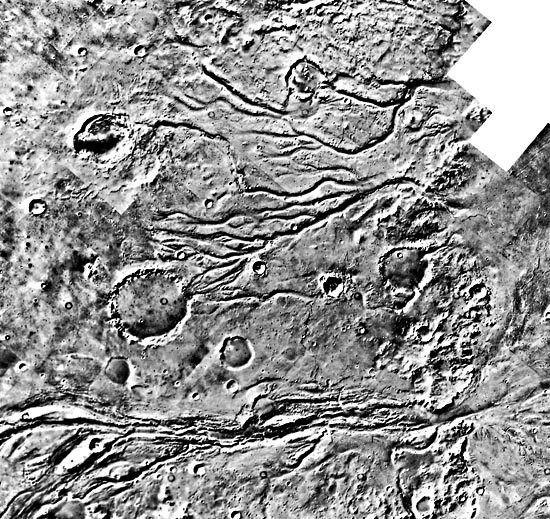
Caption: A network of channels on Mars.
This is a Viking Orbiter image showing a region just west of the Viking 1 Lander site in Chryse Planitia. Probably the coordinates are about 25 N, 50 W.
The image is about 300 x 300 km.
The network of channels strongly suggests rainfall and surface runoff: i.e., they could be rain-fed runoff channels.
But they could have been formed by groundwater sapping.
In groundwater sapping, liquid groundwater eats away at a cliff face. One images the water as frozen until some geothermal event temporarily melts it and this leads to groundwater sapping.
Whether or NOT this network is due to rain-fed surface runoff, I don't know.
But in fact, the current thinking is that the some channels are Mars do indicate some persistent flow and rain.
But rain and run-off rivers were probably very intermittent.
It has been suggested that major impacts may somehow ??? have heated Mars for a few decades every few million years and thus brought about an intermittent wet Mars (publicized by Kerr, R. A., 2003jun06, Science, 300, 1496).
On the other hand, periods of intense volcanism may have temporarily given Mars a thickish CO_2 atmosphere that in turn gave Mars's enough greenhouse effect for surface liquid water and rain (HI-194).
Current thinking is that Mars was always too cold to be continuously wet (publicized by Kerr, R. A., 2003jun06, Science, 300, 1496).
But the story could change again---it keeps doing that, you know.
Credit/Permission: NASA, Viking 1 Orbiter (1976--1980), before or circa 1980 / Public domain.
Download site: NASA: GEO_PLATE_P-8.HTML. Alas, a dead link.
Image link: Itself.
There are in fact a huge number of gully images and other images from the Mars Global Surveyor's Orbiter Camera (MOC). See Malin Space Systems: Mars Global Surveyor Mars Orbiter Camera Captioned Image Releases.
But was there ever continuous running water on Mars?
Even before the Mars Exploration Rovers (Spirit (2004--2010) and Opportunity (2004--2018)), there was confirming evidence that Mars had continuous running water for some significant periods of time: years? decades? centuries? megayears? I havn't found any estimates yet.
The confirming evidence came from the Mars Global Surveyor and is shown in the figure below.
So yes, Mars, had at least rivers and bodies of water of some size.
- It proves there was persistent
water
flow on Mars.
Water channels have been long identified on Mars, but they it is argued that they could be due to flood events due sudden heating of frozen water: volcanic or impact heat would be the cause.
But to form a fan with typical fan features like oxbows (see below) takes time.
- The fan is marked out by sedimentary rock. The fan channels
are now raised above the surroundings. The sedimentary rock
must have been cemented harder than the surroundings.
Probably wind erosion has worn away the surroundings.
- It seems likely that the fan flowed into a body of water:
perhaps a small lake.
- Box c shows an oxbow is a loop in a meandering river typical
of the Mississippi River for example.
A cut-off meander has pinched off the oxbow: this is typical of meandering Earth rivers and requires persistent flow.
Note the impact crater to the east of box c. This crater is superimposed on the fan and so came later.
- Box d shows crossed channels with one clearly lower than the
other. This indicates the fan persisted long enough to reform
and cut new channels.
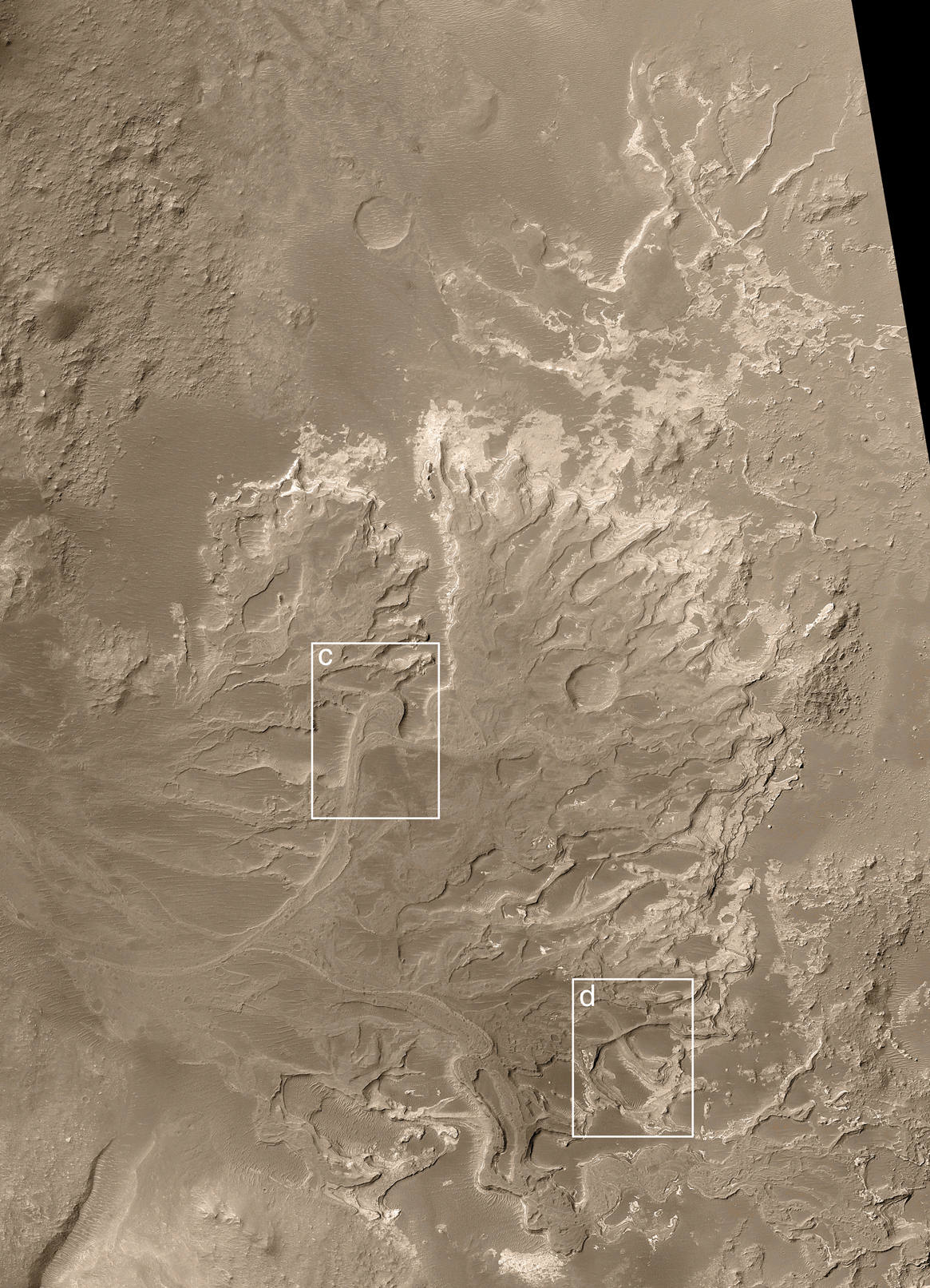
Caption: A distributary fan on Mars. From the Mars Global Surveyor's Mars Orbiter Camera (MOC), 2003nov13. Image MOC2-543a.
The fan is 24.3 S, 33.5 W. The image is 14 x 19.3 km. The fan is located in a partially destroyed impact crater of diameter 64 km.
A distributary fan is a river delta or similar alluvial feature.
The fan is important for 3 reasons:
Clearly, Mars didn't have a lot of water channels and lakes or else the evidence has been destroyed by long ago volcanism and cratering.
Credit/Permission: NASA, Malin Space Science Systems, 2003 / Public domain.
Downlaod site: MGS MOC Release No. MOC2-543, 13 November 2003.
Image link: Itself.
- The Mars Ocean Hypothesis:
-
Other than in the imagination of Giovanni Schiaparelli (1835--1910)
that is.
The 800 lb gorilla of an idea is the Mars Ocean Hypothesis that posits that virtually the whole blue region in the topographic map in the figure below was an ocean about 3.8 gigayears ago.
However, the Mars Exploration Rovers (Spirit (2004--2010) and Opportunity (2004--2018)) have added some evidence in favor of oceans and have proven that there were at least desert basin salt lakes.
Some images illustrating the mission of the Mars Exploration Rovers are shown in the three figures below.
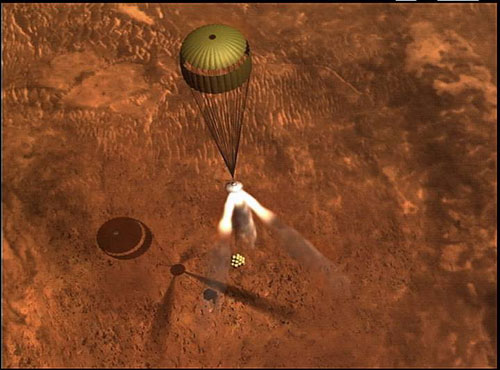 Parachute descent.
Parachute descent.
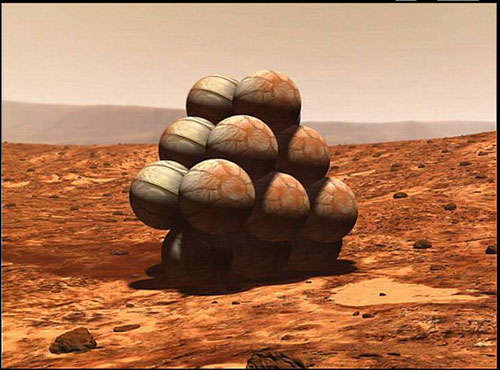 Airbag encased and at rest on Mars.
Airbag encased and at rest on Mars.
Caption: Artist conceptions of how the Mars Exploration Rovers (Spirit (2004--2010) and Opportunity (2004--2018)) landed.
Credit/Permission: NASA, JPL, before or circa 2005 / Public domain.
Download site: NASA/JPL: America's Spirit Is Ready to Rock-n-Roll Martian Style Saturday Night.
Image 1 link: Itself.
Image 2 link: Itself.
Image 3 link: Itself.
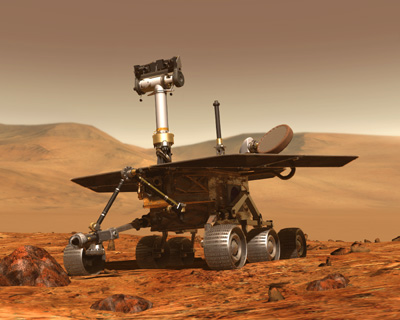 Caption: Mars Exploration Rover,
artist conception, 2004.
Caption: Mars Exploration Rover,
artist conception, 2004.
Credit/Permission: NASA, JPL, before or circa 2005 / Public domain.
Download site: NASA/JPL: https://mars.jpl.nasa.gov/mer/gallery/artwork/images/rover1_400.jpg .
Image link: Itself.
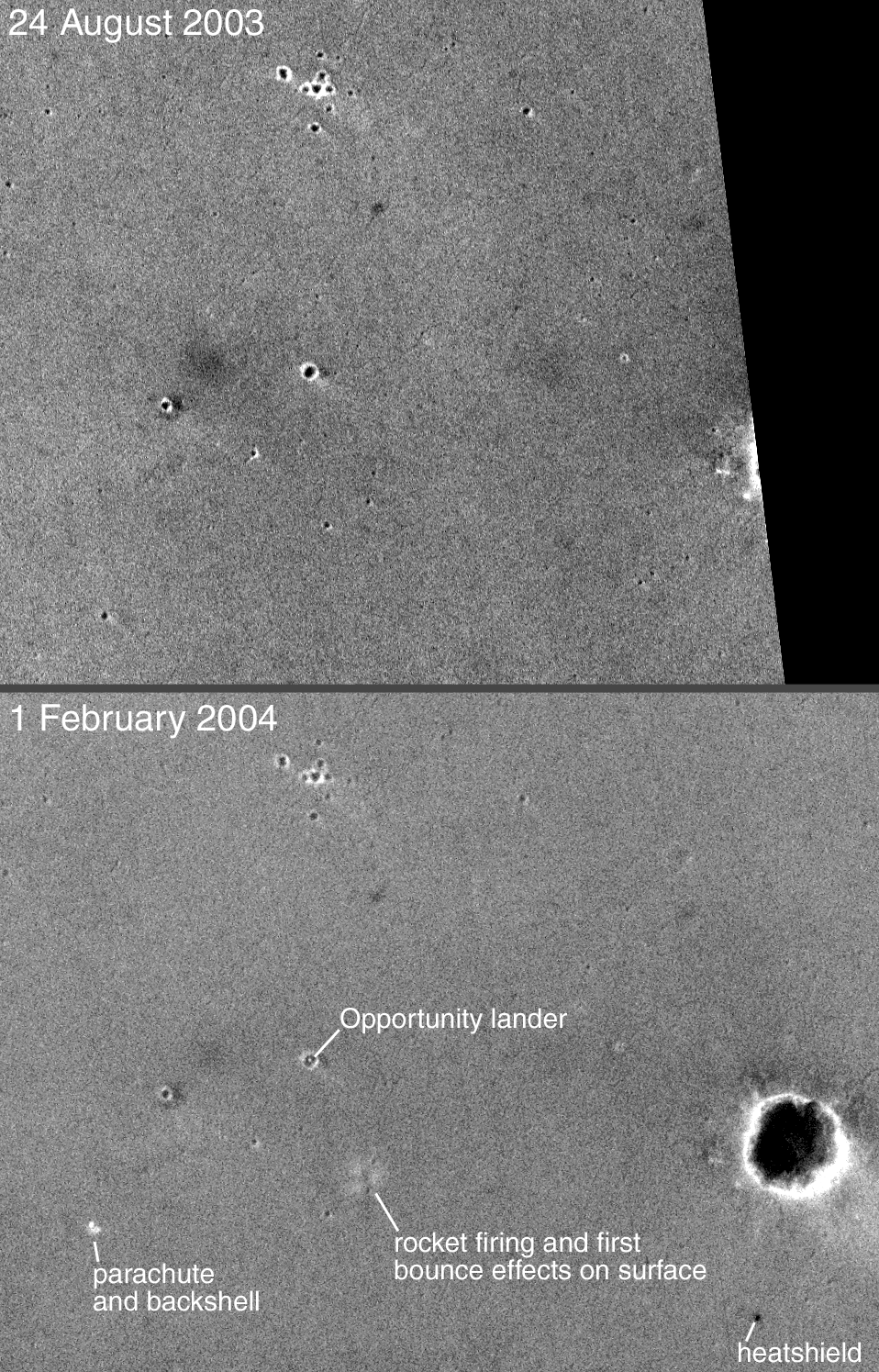
Caption: Mars Global Surveyor's Mars Orbiter Camera (MOC) images of Opportunity landing site. 2003aug24, 2004feb01.
The Mar Exploration Rover Opportunity landed 2004jan25 on Meridiani Planum near 2.0° S, 5.6° W.
North is at the top, east is at the right, and the lower image is about 1.4 km wide.
Opportunity came to rest in a small crater of approximately 20 m in diameter.
Credit/Permission: NASA, JPL, 2004 / Public domain.
Download site: NASA/Malin Space Science Systems: MGS MOC Release No. MOC2-635, 13 February 2004.
Image link: Itself.
And the evidence from the Mars Exploration Rovers for oceans and at least desert basin salt lakes is shown in the dramatic figure below. These kind of images just make geologists go wild.
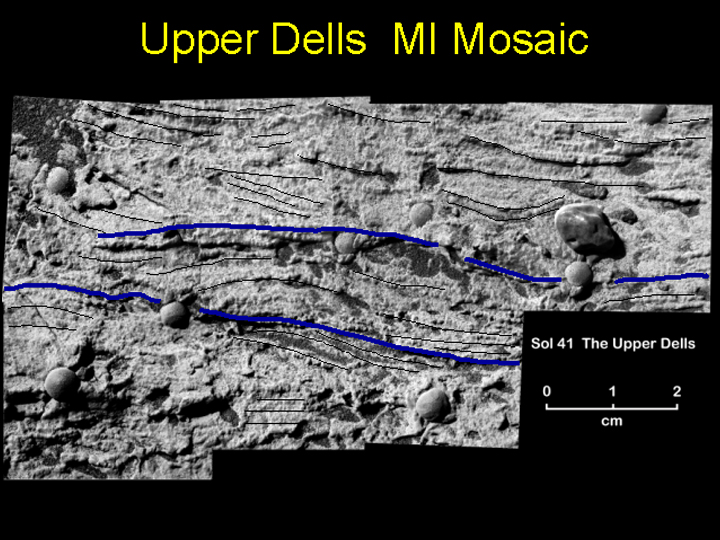
Caption: A view of a cross-laminated, sedimentary rock. Opportunity, 2004mar05.
The fine layers (laminae) in this rock are ``truncated, discordant and at angles to each other.''
I assume that these layers are the cross-laminae and there appearance means the rock is cross-lamination.
The BLACK LINES trace the cross-lamination and the BLUE LINES possible boundaries between sets of cross-laminae. Possibly the sets were laid down at different times???.
Cross-lamination indicates that these sediments were laid down by flowing water. The water flow was perpendicular to the plane of the image either inward or outward.
The water was 5 cm deep or so or much deeper and the flow speed was about 10 to 50 cm/s.
Chlorine and bromine in the rock suggests that the sediments were laid down in salty water where the concentrations of salts exceeded the saturation due to evaporation.
The formation enviromment may have been a sea shore or desert basin.
Credit/Permission: NASA, JPL, Cornell University, USGS, 2004 / Public domain.
Download site: NASA: Standing Body of Water Left Its Mark in Mars Rocks. See also NASA/JPL/Cornell/USGS: Standing Body of Water Left Its Mark in Mars Rocks. Image link: Itself.
It seems that Opportunity in the Meridiani Planum was the lucky landing site with lots of water evidence. Spirit in Crater Gusev has come up dry it seems.
The Curiosity Mars rover also found evidence of water. See the figure below.

Caption: "Where Water Flowed Downslope.
This image shows the topography, with shading added, around the area where NASA's Curiosity rover landed on Aug. 5 PDT (Aug. 6 EDT). Higher elevations are colored in red, with cooler colors indicating transitions downslope to lower elevations.
The black oval indicates the targeted landing area for the rover known as the "landing ellipse," and the cross shows where the rover actually landed.
An alluvial fan, or fan-shaped deposit where debris spreads out downslope, has been highlighted in lighter colors for better viewing. On Earth, alluvial fans often are formed by water flowing downslope. New observations from Curiosity of rounded pebbles embedded with rocky outcrops provide concrete evidence that water did flow in this region on Mars, creating the alluvial fan. Water carrying the pebbly material is thought to have streamed downslope extending the alluvial fan, at least occasionally, to where the rover now sits studying its ancient history. Elevation data were obtained from stereo processing of images from the High Resolution Imaging Science Experiment (HiRISE) camera on NASA's Mars Reconnaissance Orbiter."
Perhaps Curiosity Mars rover's greatest discovery is that a of minerals showing the presence of liquid water once---hundred of millions of years ago? or billions?---that was chemically safe for life---NOT too acidic or alkaline.
The previous minerals showing water formation showed unsafe conditions for life.
Credit/Permission: NASA/Jet Propulsion Laboratory (JPL)-Caltech/University of Alabama, 2012 (uploaded to Wikipedia by User:Drbogdan, 2012) / Public domain.
Image link: Wikipedia: File:PIA16158-Mars Curiosity Rover-Water-AlluvialFan.jpg.
There are lots more Mars Exploration Rover images and results, but that's enough for now.
The site Views of the Solar System: Mars offers a good selection of rover and other images of Mars.
See also Mars videos below (local link / general link: mars_videos.html):
There is more than yours truly can say.
So we skim?
-
Group Activity:
Form groups of 2 or 3---NOT more---and tackle Homework 14 problems 9--14 on Martian geology etc.
Discuss each problem and come to a group answer.
Oh, 5--10 minutes.
See Solutions 14.
The winners get chocolates.
- Life on Mars
-
Is there or has there ever been
life as we know it on Mars
(i.e., Martian life)?
- Martian Life Possibly:
From the discussion above in the section Water on Mars, it seems that Mars was sometimes warmish and wet.
In other respects, early Mars was also probably like early Earth with a CO_2 and water vapor atmosphere.
We think that microbial life first appeared on Earth 3.465 Gyr ago at least and perhaps 4.28 Gyr ago (see Wikipedia: Earliest known life forms; Wikipedia: Abiogenesis). But we don't know how exactly it arose. But somehow:
-
Life
was thus an almost utterly improbable event with almost infinite
opportunities of happening. So it did.
-
---James Lovelock (1919--),
the proposer of the
Gaia hypothesis.
Quotation from Tim Radford, Nature,
2019 Jun25.
Thus, it is possible that microbial life arose quickly on early and sometimes warm and wet Mars.
- Transpermia:
It is also possible that life originated once on either Earth or Mars and was transferred to the other by impact events. Or perhaps some more complex multiple origins and transfers happened.
The process of life spreading through impactor-ejected rock has been called transpermia. See P.C.W. Davies: How bio-friendly is the universe.
The cartoon in the figure below illustrates transpermia in action.
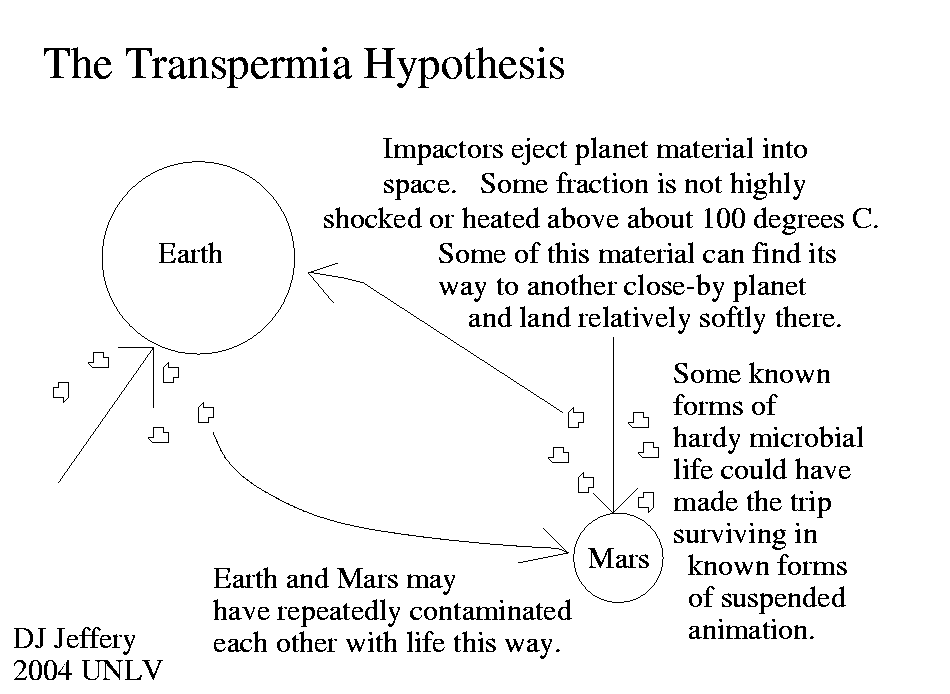
Caption: The transpermia hypothesis.
Credit/Permission: © David Jeffery, 2004 / Own work.
Image link: Itself.
An impactor throws rocks containing microbes into space.
The microbes stay in some kind of suspended animation and then re-animate if the rock impacts on a hospitable planet.
The rocks have to stay below about 100° C and be relatively unshocked, but calculations show that some material will stay this cool and unshocked both through ejection and impact.
Significant transfers of materials between planets do happen this way and it is believed that some kinds of microbial life would survive the journey.
Biological contamination back and forth between Earth and Mars may even have happened repeatedly in the early solar system.
Reading about transpermia has given me more confidence in the possibility of Martian life---but Martian life affected by transpermia will probably NOT be independent of Earth life.
- Famous, But Largely Dismissed, Evidence for Life on Mars:
And there is some famous, but largely dismissed, evidence for microbial life on early Mars.
The evidence is meteorite Allan Hills 84001 show and described in the figure below.
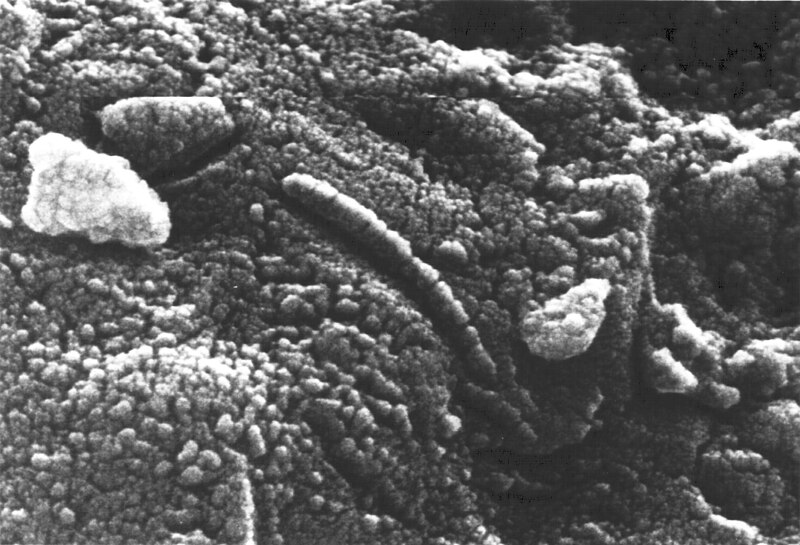
Caption: A microscopic image of the interior of meteorite Allan Hills 84001.
Allan Hills 84001 was found in Antarctica. It impacted about 13,000 years ago and left Mars about 16 Myr ago when an impactor knocked into space (Se-589), where many meteorites are found to the special conditions there (see Wikipedia: Meteorite: Antarctica).
Analysis of gas bubbles inside confirm that it is a Mars rock.
The rock itself is very old and formed about 4.5 Gyr ago (HI-196).
An analysis by some NASA scientists in 1996 suggested that Allan Hills 84001 contained fossils of microscopic Martian life that entered it long after formation.
They suggested elongated structure in this picture was Martian microbe.
To say the least this suggestion has been controversial. There has been a lot of back and forth and it seems no unanimous answer has been reached.
But I think the majority view is strongly against the structures being fossilized microbial life.
Credit/Permission: NASA, 1996 (uploaded to Wikimedia Commons by User:User:Complex01, 2005) / Public domain.
Image link: Wikimedia Commons: File:ALH84001 structures.jpg.
- Life on Mars Today?
). It's all very uncertain though.Could life still exist on Mars today?
Well there can't be life as we know it on the surface---unless it can carry its own liquid water supply and shield itself from ultraviolet (UV) light.
-
Recall life
on Earth is protected from dangerous
UV radiation
our atmosphere, particularly the ozone layer 25 km
above the surface (Se-439).
Mars doesn't have this shielding and the surface
life (unless it
had its own shielding)
could NOT survive there even if it were warm enough and had water.
But that evidence has been recently disputed. A re-analysis of Viking lander tests suggests that they did find organic compounds after all (Washington Post: New Mars tests find possible life ingredients, 2010sep03
We need fresh tests for organic compounds in Martian soil and remarkably none of the landers since Viking have done those tests.
-
Organic compounds are essential
for life as we know it, but
can in many cases be produced non-biologically too and
so do NOT prove life exists in themselves.
But microbial life could exist in the aquifers that probably exist below the surface or in other moist subsurface environments? Recall it seems likely that aquifers exist today (HI-195).
Earth provides us with evidence by analogy.
Since circa 1990, we have known microbial life on Earth reaching down to 3 km or more below the surface. This deep life has been collectively called the deep biosphere.
Additionally, microbial life discovered 3.5 km below the Antarctic ice. This life has been isolated from the surface for more than 1 Myr.
It has also been claimed that some terrestrial microbes can be dormant for 100 Myr or more (HI-157). So its possible that Martian life could endure long periods of poor conditions and resurrect in better times.
So it seems possible that something like Earth microbes could live on Mars below the surface today.
But do they?
- Probes for Martian Life:
So we have both possibilities: life in the past on Mars and life today.
To find out we need probes.
The Mars Exploration Rovers (Spirit and Opportunity first operational 2004) did NOT find evidence of life: e.g., fossil remains.
The European Space Agency's (ESA's) Mars Express Orbiter (first operational 2003) found a bit of evidence consistent with life as we know it.
Mars Express Orbiter is shown in the figure below.
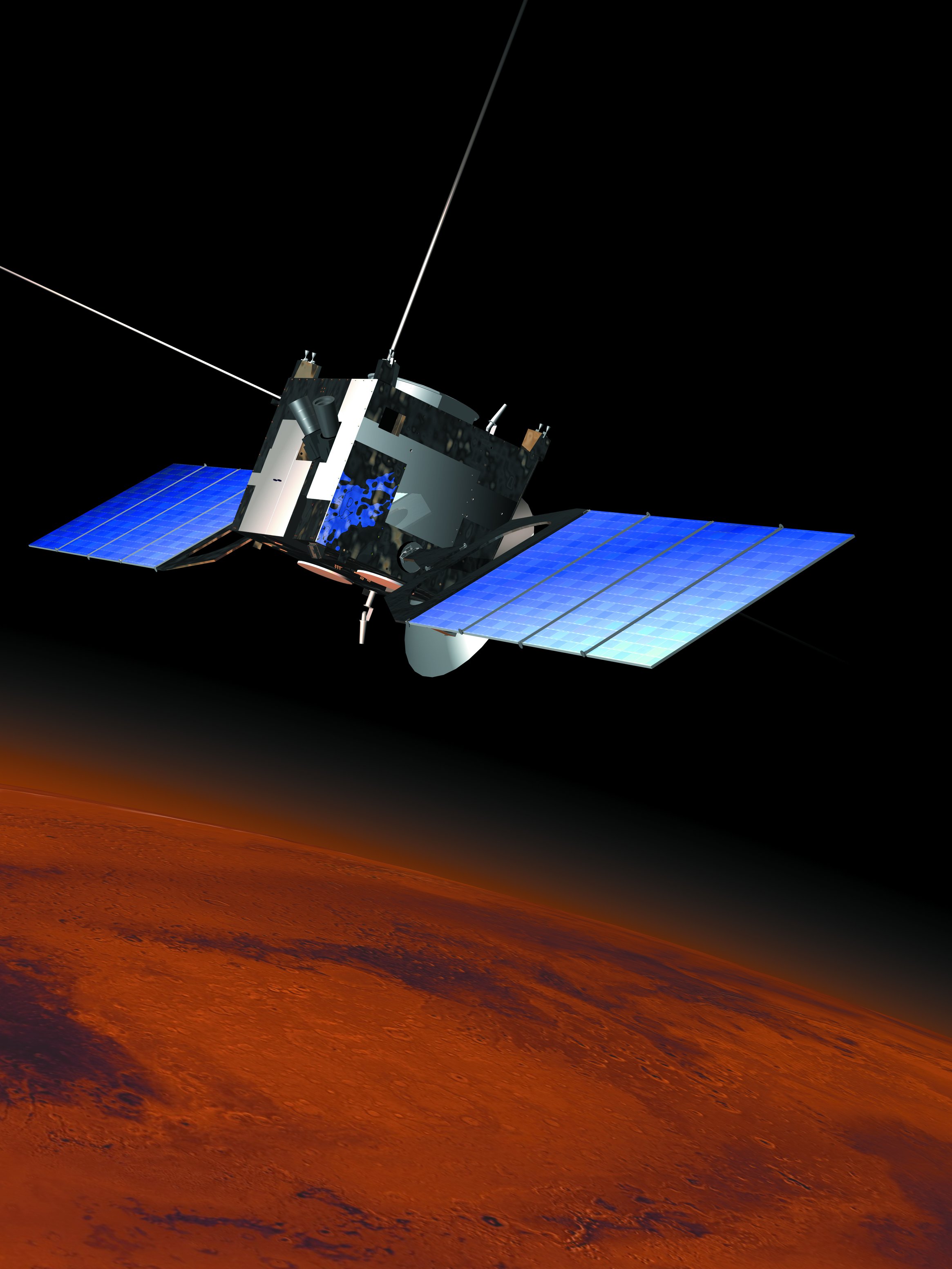
Caption: The European Space Agency's (ESA's) Mars Express Orbiter, first operational in 2003.
The Mars Express Orbiter has imaging and spectroscopic capability.
Credit/Permssion: ESA, 2001 / ESA gives permission for educational use and reproduction.
Downlaod site: ESA 2001, Illustration by Medialab.
Image link: Itself.
The evidence?
Mars Express Orbiter has spectroscopically confirmed the existence of methane (CH_4) in the Martian atmosphere (see ESA Press Release: Mars Express confirms methane in the Martian atmosphere; Wikipedia: Atmosphere of Mars: Methane).
The amount detected is tiny: 0.01 ppm = 10 ppb.
Methane is a main component of natural gas.
But methane CANNOT last in the Martian atmosphere for more than a few centuries because it breaks up to form CO_2 and water using oxygen present in some form.
Therefore methane must be continually produced on Mars.
Volcanic or hydro-thermal activity on Mars could produce methane.
If this is the source, then it confirms our believe of continuing primordial-radiogenic heat geology.
On the other hand, methane can be produced biologically (e.g., by fermentation).
So the possibility of subsurface microbial life is raised.
Further studies of the abundance and distribution of methane might yield more insight.
- Earth Invades!
In the search for Martian life, we may get lucky.
The Mars Exploration Rovers (2003--2018) (Spirit (2004--2010) and Opportunity (2004--2018)), did NOT find fossils---but some new rover could tomorrow---and tomorrow is just a daaaay awaaaay.
-
But maybe Spirit (2004--2010) and
Opportunity (2004--2018) are it---as
John Updike (1932--2009) hinted:
Duet on Mars (2004).
It would be a pity if there were no Martians (see the figure below: local link / general link: alien_prototype_are_here.html) to observe our slow-motion invasion.
It is The War of the Worlds (1898)---first, we send our monster robots, then ...
- Transpermia:
Life as we don't know it is harder to debate. There is no evidence of it existing at all. But who knows.
- Mars in Myth and Early History:
